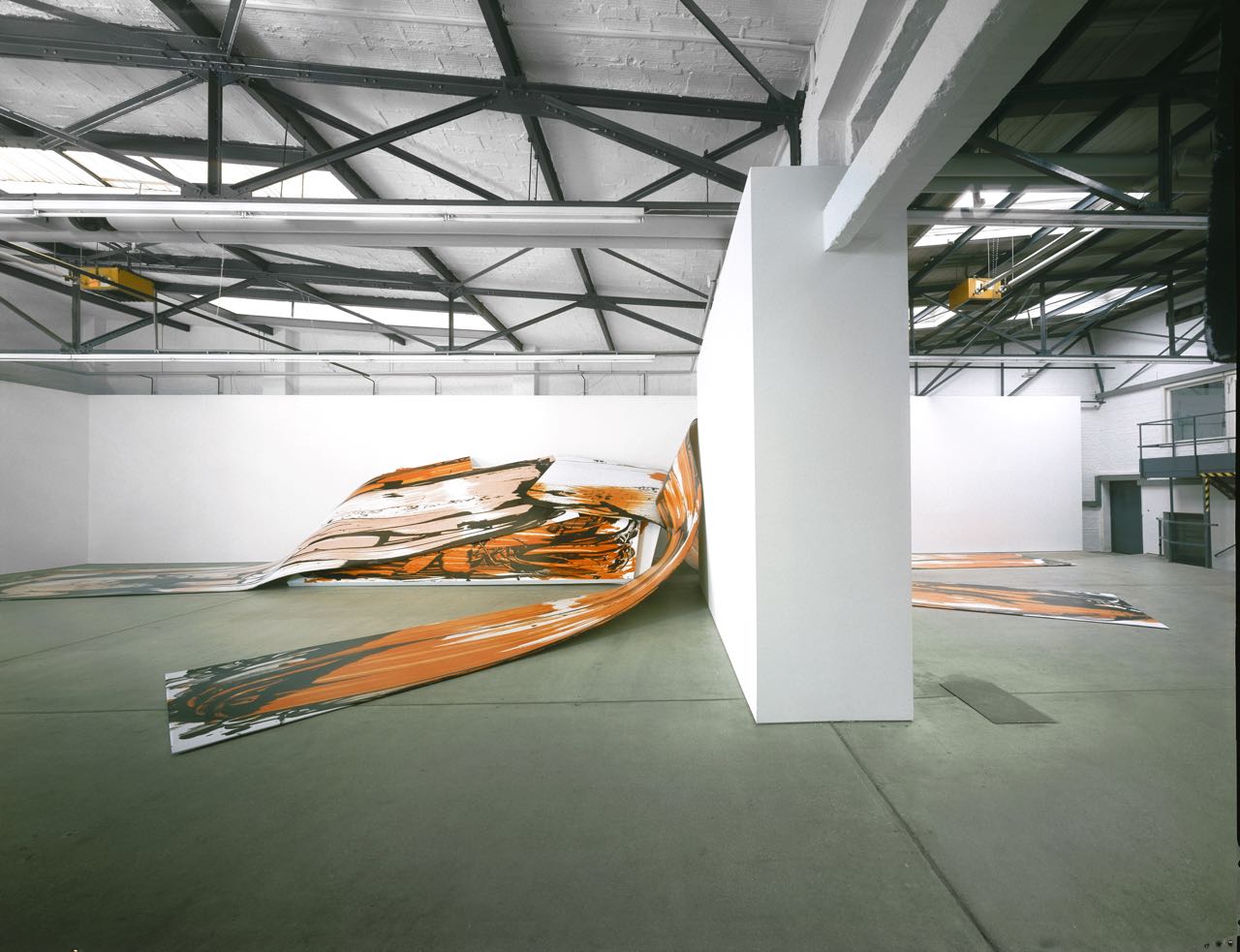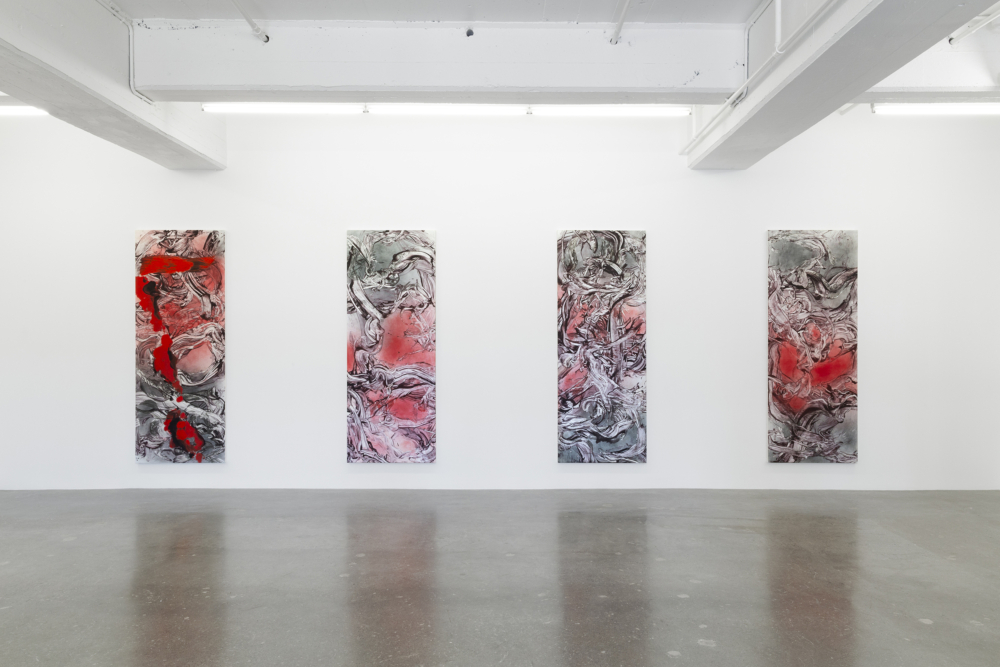
Cry Sea, Cry Sky Robert Heald Gallery, Wellington, Aotearoa/New Zealand
25 January – 24 February 2024
Here You Are, 9 March – 20 April 2024, Michael Lett Gallery, Auckland / Tamaki Makaurau, New Zealand

Cry Sea, Cry Sky Robert Heald Gallery, Wellington, Aotearoa/New Zealand
25 January – 24 February 2024
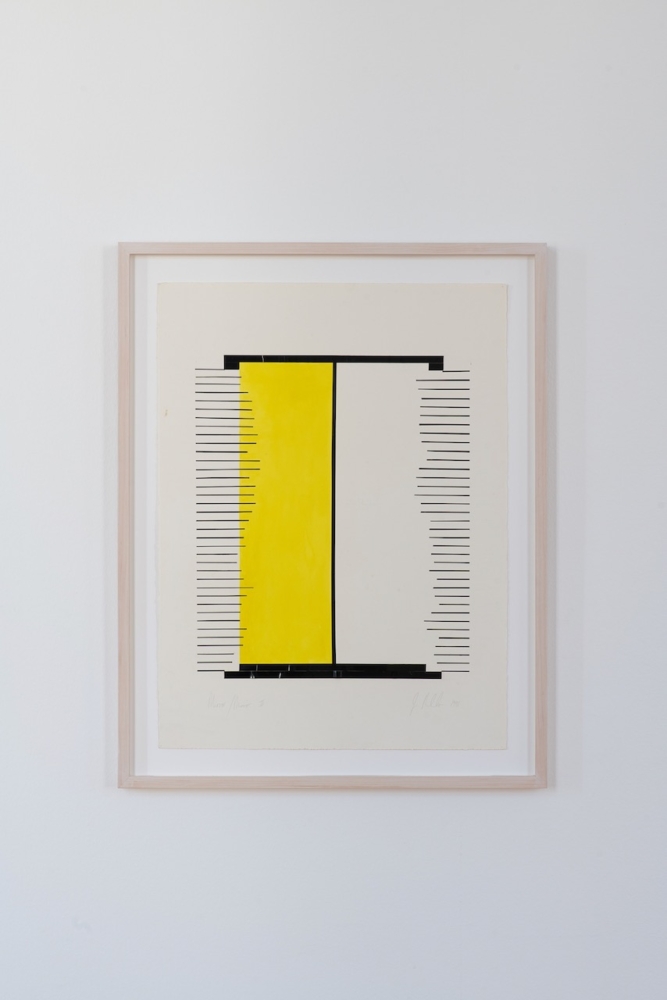
Spotlight, Kunstmuseum St Gallen, Switzerland: 25 November 2023- 24 March 2024
Spotlight focuses on the individual artists for whom Kunstmuseum St Gallen holds significant bodies of work: John M. Armleder, Candice Breitz, Silvie Defraoui, Georg Gatsas, Sharon Hayes, Sara Masüger, Judy Millar, and Carl Ostendarp.
Malerei – Galerie Mark Mueller, Zurich www.markmueller.ch
11 November – 23 December 2023
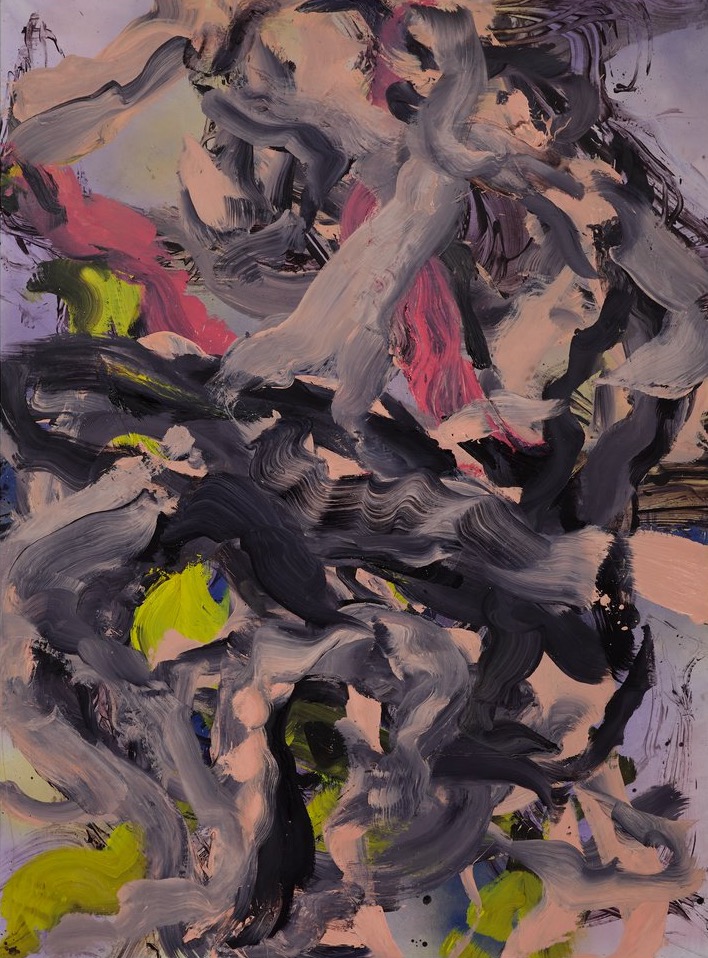
Robert Heald Gallery Wellington, New Zealand presents Paintovers – Opening 12 March 2020
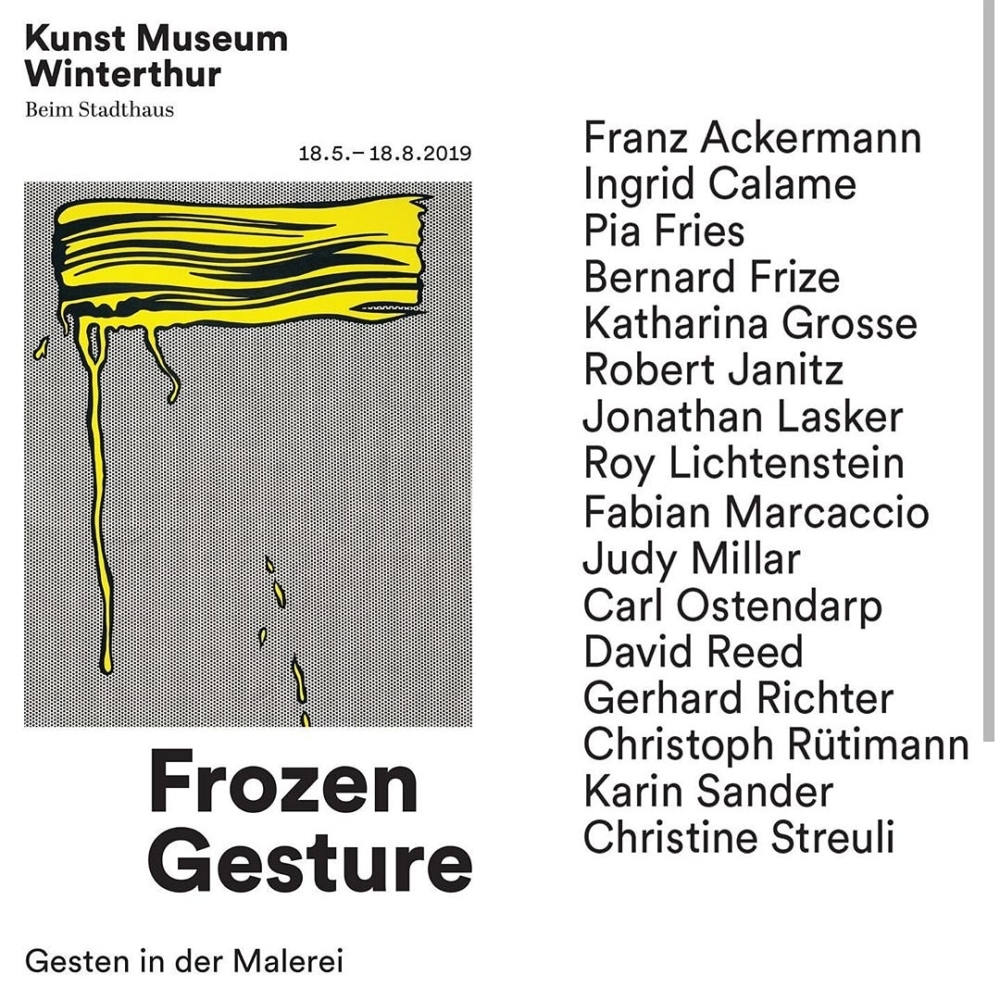
Frozen Gesture Kunst Museum Winterthur, Switzerland. 18th May – 18th August 2018
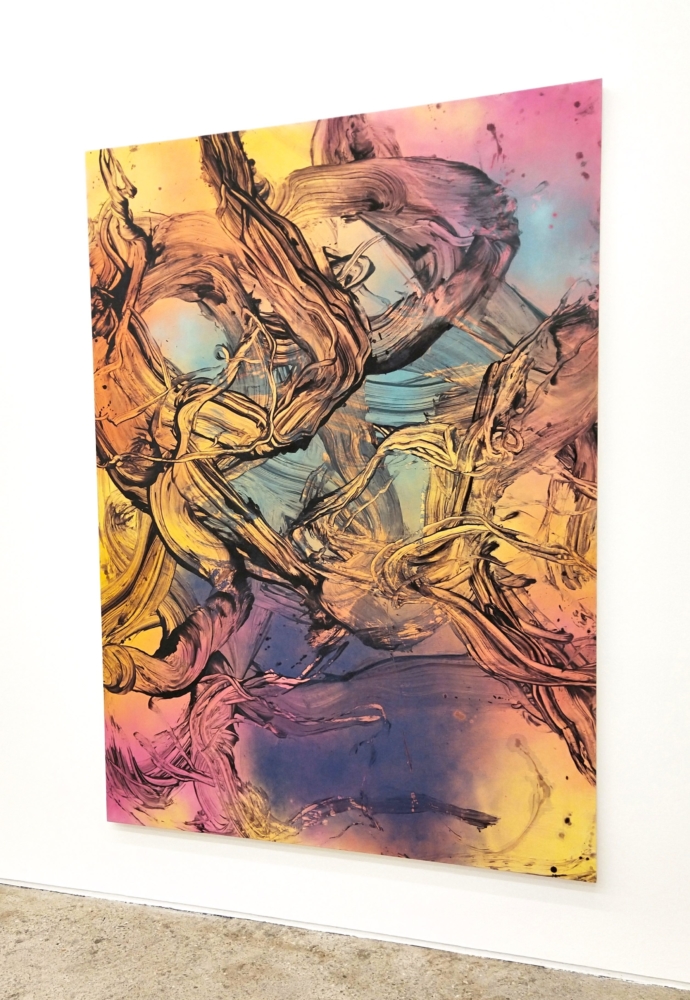
Galerie Mark Mueller, Zurich presents the group exhibition Single, but happy. 8th June – 20th July
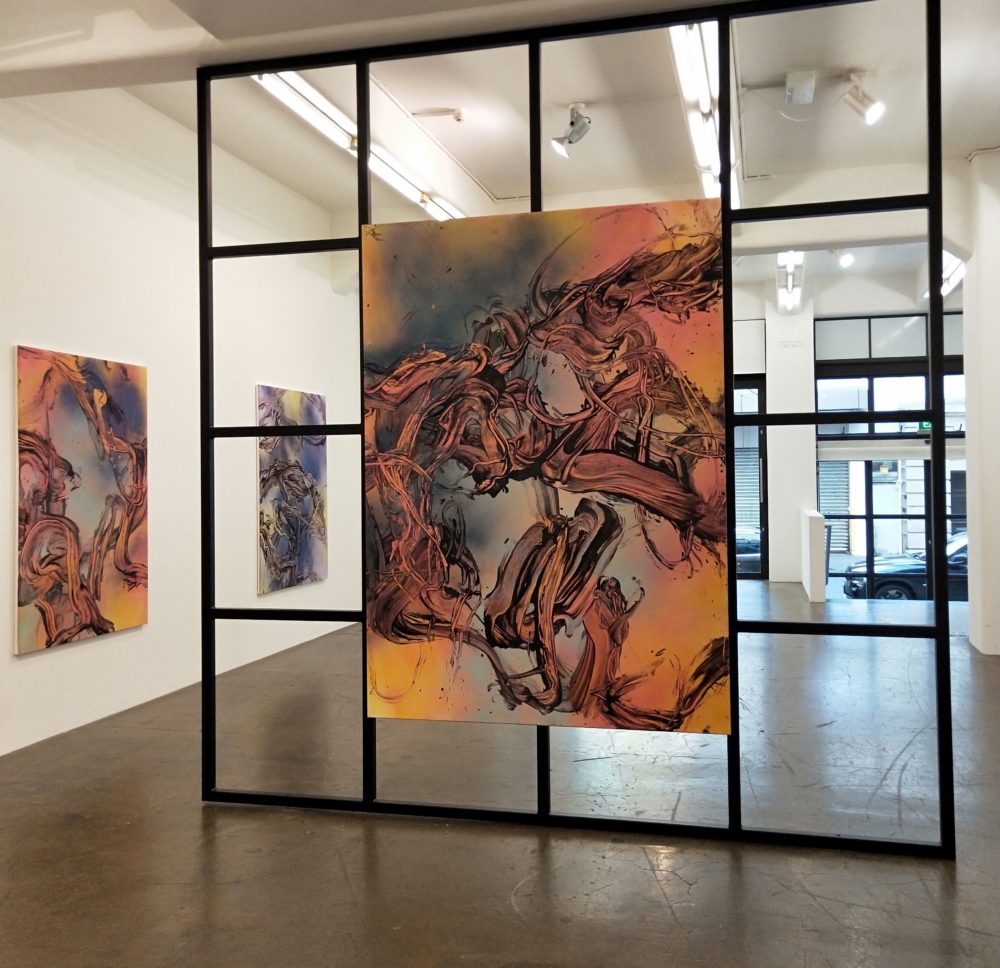
Gow Langsford Gallery, Auckland, New Zealand presents A World Not Of Things, a solo exhibition of new paintings by Judy Millar. 17th April – 4th May 2019
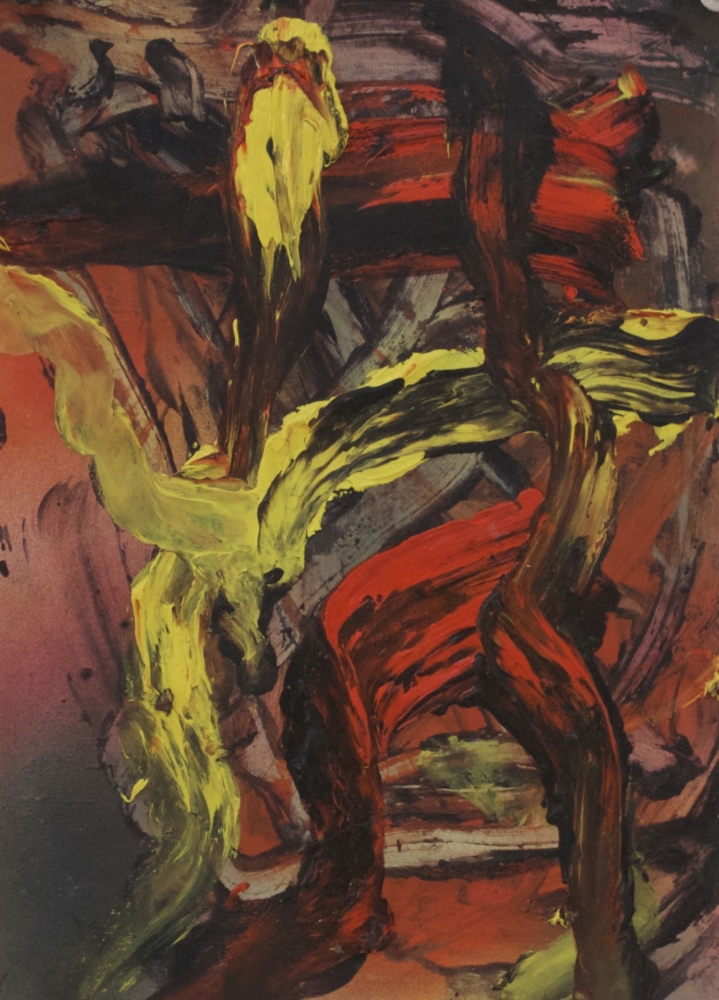
Most encounters with Millar’s paintings over the last decade have asked the viewer to step back a few paces to comprehend dramatic gesture at much larger than life size. These small studies invite a completely different mode of observation: up close and personal.
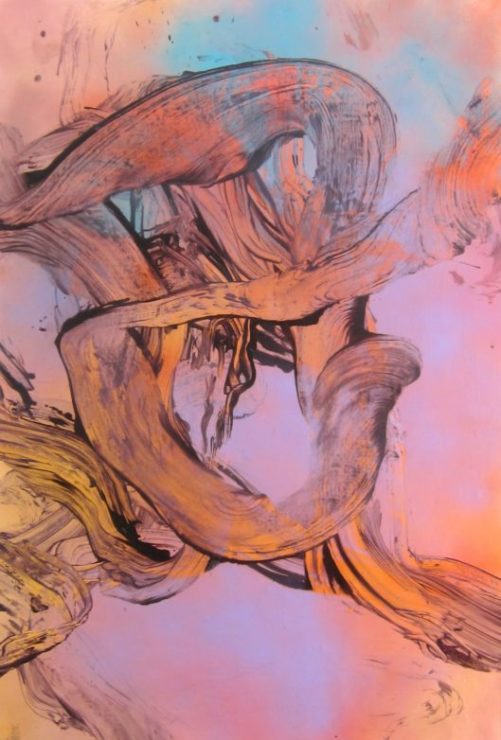
A group exhibition curated by Kate Britton for Sullivan+Strumpf Sydney from 18th August 2018 – 15th September 2018.
Without our body we don’t exist, this to me is our experience of the world and this is what paintings can directly address.
Constant artistic experimentation and mystic inquisitiveness, engage and invigorate.
Solo show at Robert Heald Gallery, Wellington. Jan 25 – Feb 17, 2018.
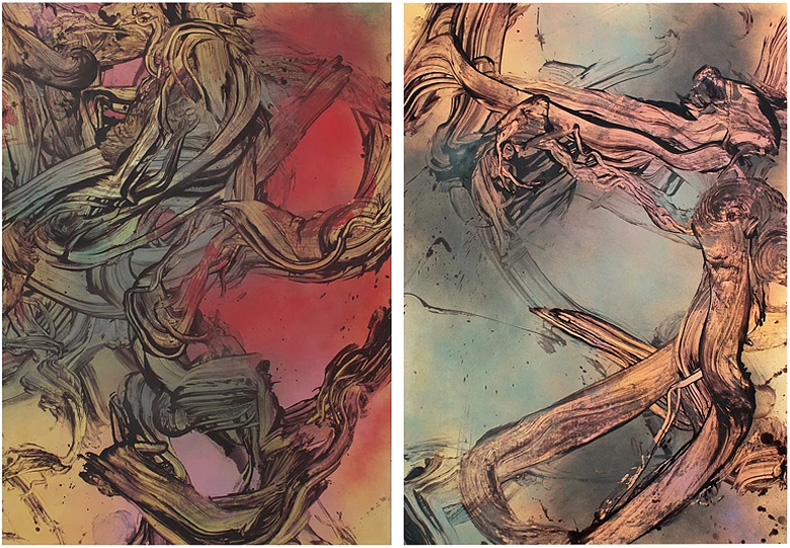
Blood red, jade green, and a bruising purple resonate against yellow and incandescent orange in Judy Millar’s new paintings.
This work plays with the complexity of the vibrant junction between the Victorian, neo-Classical and 21st century architecture of the building.
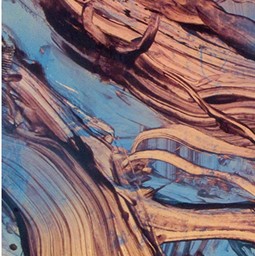
Solo show at Gow Langsford Gallery, Auckland, New Zealand. 2016.
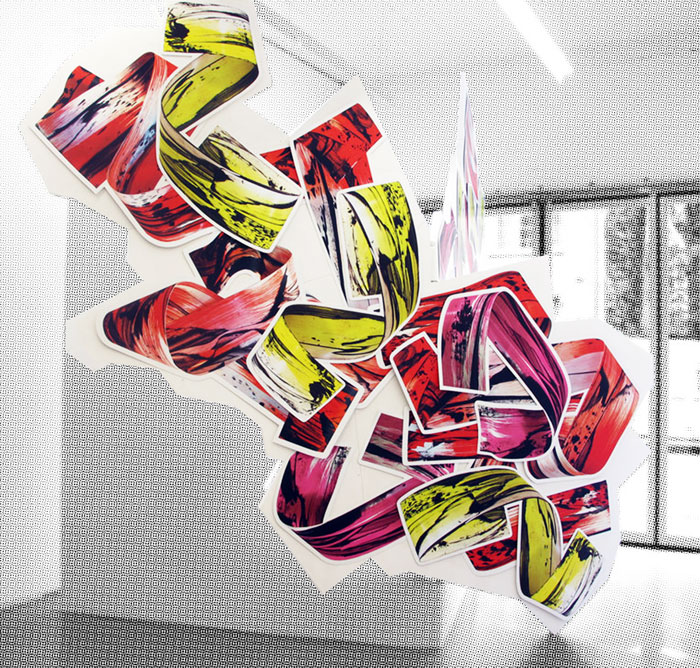
Featuring Advancing All Electric – part of a group show at Galerie Mark Mueller. 2016
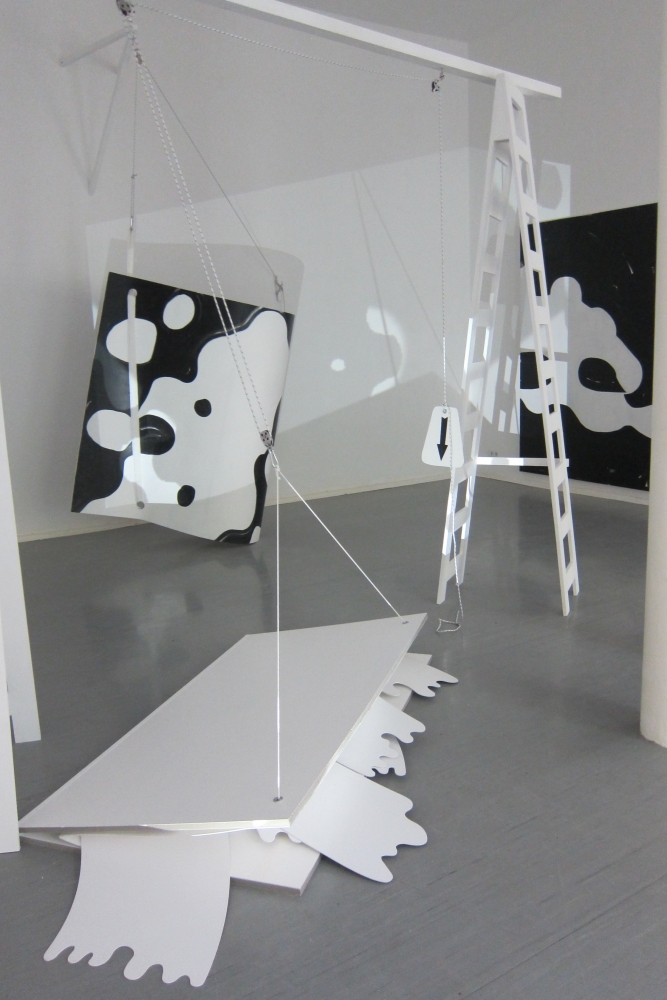
Group show at Frontviews Temporary, Kunstquartier Bethanien, Berlin. 2015.
Multi-media Installation at Te Uru Contemporary Gallery. 2015.
Press release for a solo exhibition at Galerie Mark Mueller. 2014.
An enchanting pop-up book full of Judy’s painted twists, twirls, swells and swirls.
A collaboration between Judy Millar and Paul Serville for the 2014 Servilles Winter campaign.
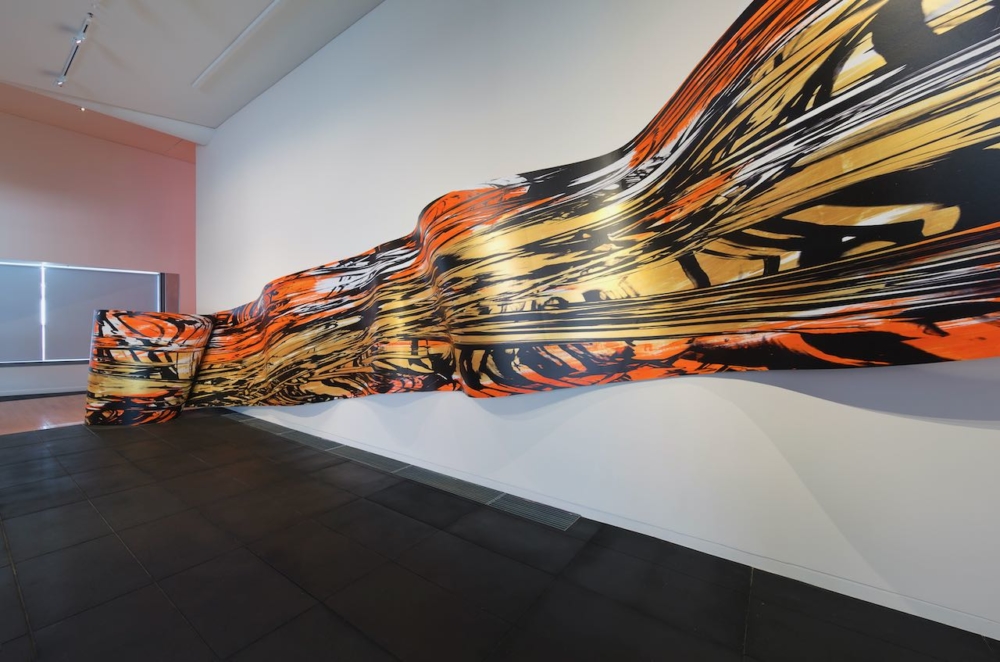
Cinema & Painting, Adam Art Gallery, Wellington, New Zealand.
11 February – 11 May 2014
This exhibition examined the intersection of these two screen-based arts against the backdrop of a culture characterized by the increasing plasticity of pictorial surfaces and flexibility of spaces of viewing.
Video of the construction of Space Work 7 commissioned for the exhibition Cinema and Painting, Adam Art Gallery, Wellington. 11 February – 11 May 2014
Solo exhibition at Sullivan + Strumpf, Sydney, 2013.
Exaggerated enlargements of handmade gestures with vivid colour.
“Contact” outlines a complex portrait of artistic production of the last forty years in Aoteaora/New Zealand.
This Collector´s Edition consists of 80 exemplars, each one comprising an original work.
Commanding brushstrokes of thin paint are wiped, erased and manipulated across the picture plane.
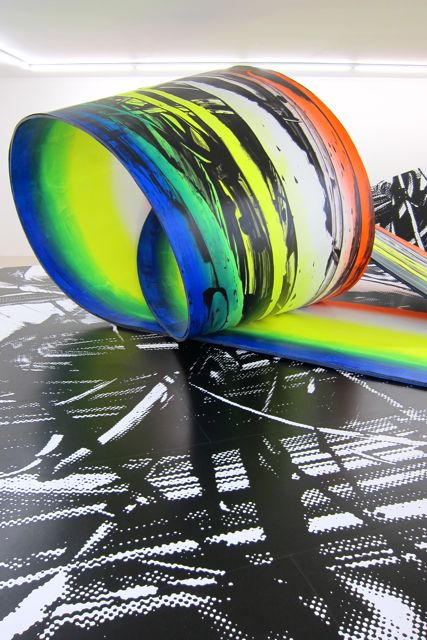
How do we distinguish between illusion and reality? How do we reconcile our physical and mental existence?
Solo exhibition Galerie Mark Mueller, Zurich, Switzerland
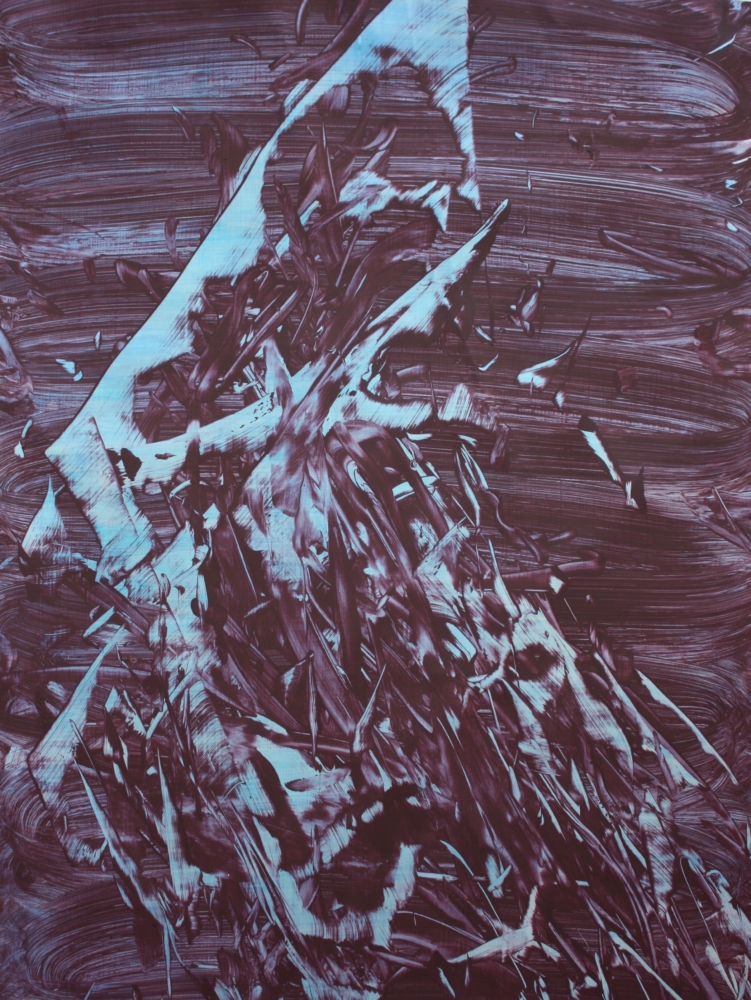
Judy Millar 08 Oct - 12 Nov 2011 A revealing aspect of abstract painting like that of Judy Millar is its minimum referential character. Colors, shapes, and movements cannot be decoded using a canon of signs taken from the world of things but function in a ...
Judy Millar 08 Oct - 12 Nov 2011 A revealing aspect of abstract painting like that of Judy Millar is its minimum referential ...
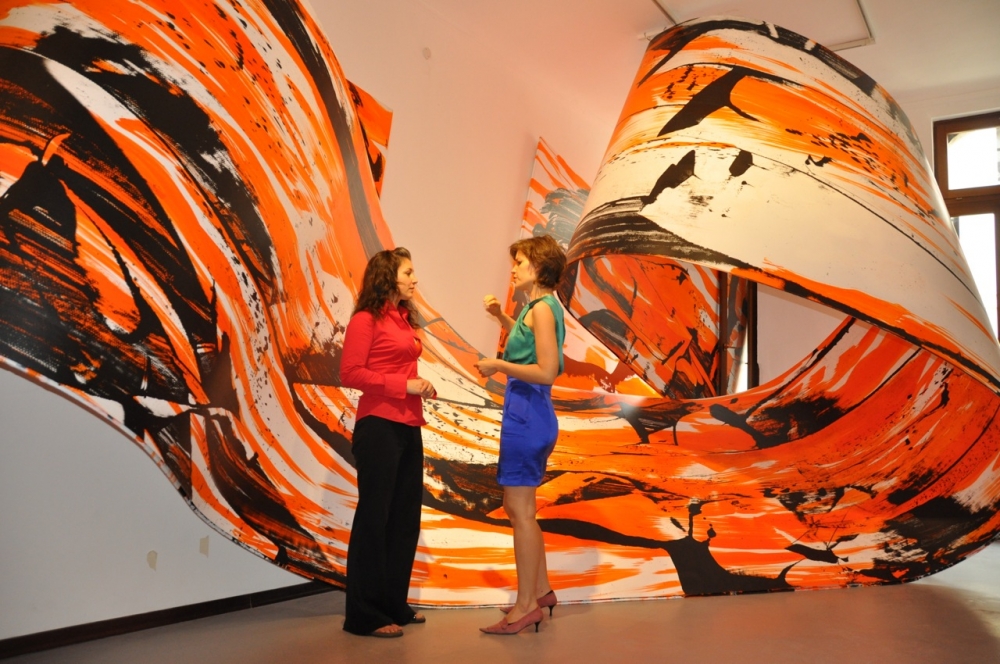
The Path of Luck Personal Structures, Palazzo Bembo, Venice, Italy 2 June 2011 – 27 November 2011 The Path of Luck 2011 wood, vinyl, paint dimensions variable ...
The Path of Luck Personal Structures, Palazzo Bembo, Venice, Italy 2 June 2011 – 27 November 2011 The Path of Luck 2011 wood, ...
Solo exhibition Gow Langsford Gallery, Auckland, New Zealand 2011
Video collection of Giraffe-Bottle-Gun from the 53rd Venice Biennale.

In 1971 an exhibition of 10 Big Paintings opened at the Auckland Art Gallery. All the exhibited artists were men. 50 years later Millar has painted the eleventh work for that exhibition.
The work was painted during the last months of 2019 as Millar felt urgency in the air and rolled out the largest canvas she could across her studio floor and got to work.
The situation of our current times as Covid-19 creates havoc and heartache across the planet is beyond anything she could have imagined.
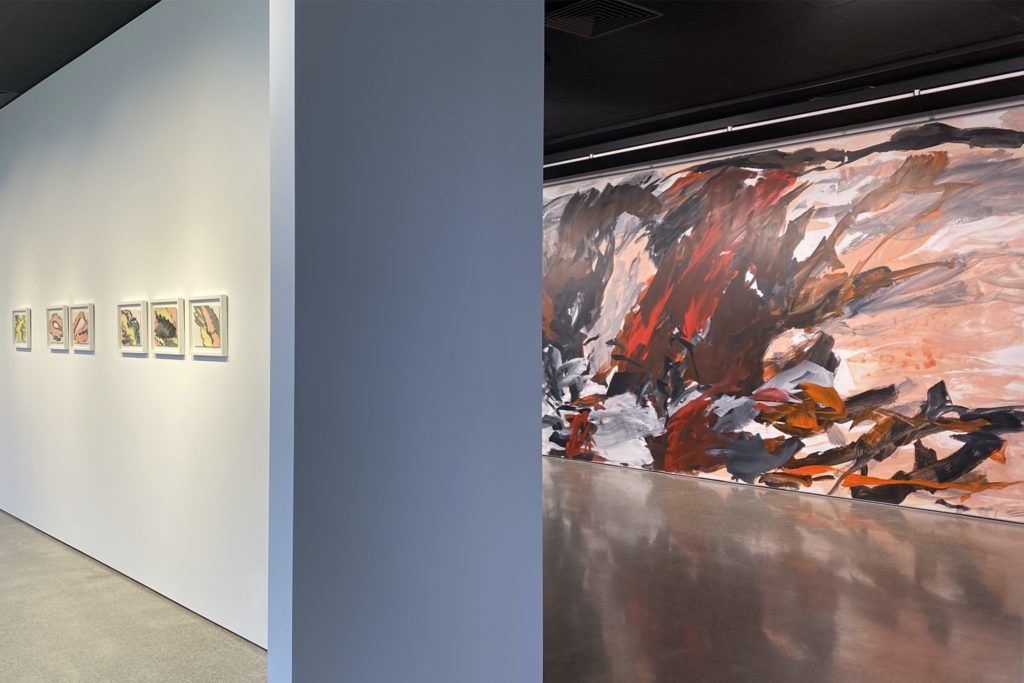
http://www.roberthealdgallery.com, Wellington, New Zealand. Opening 12 March 2020
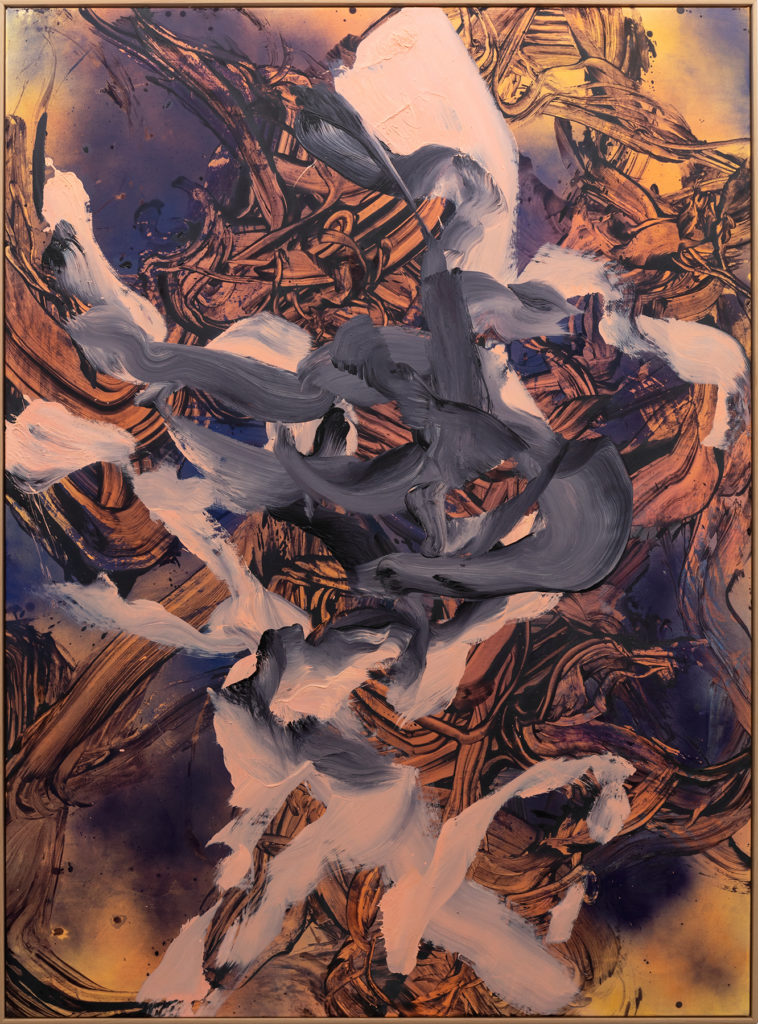

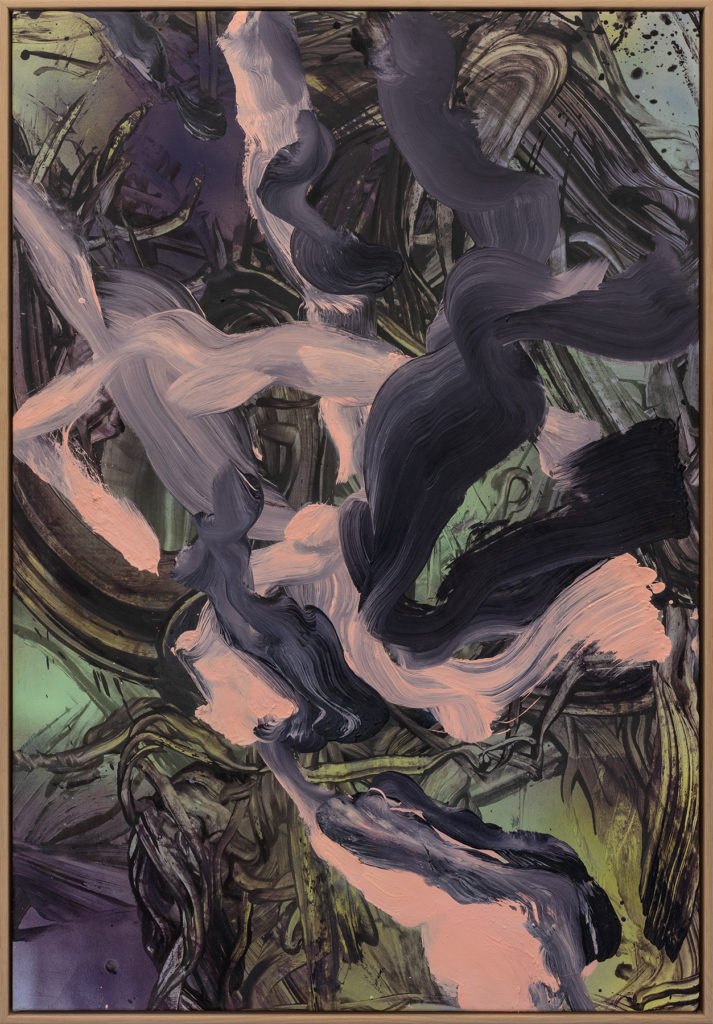
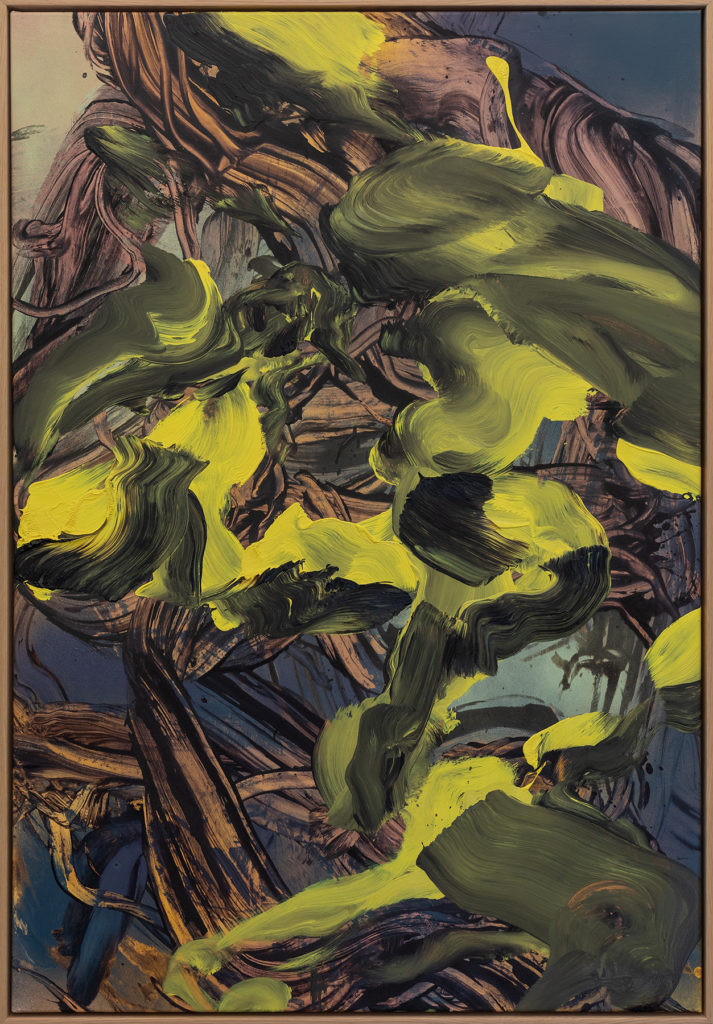
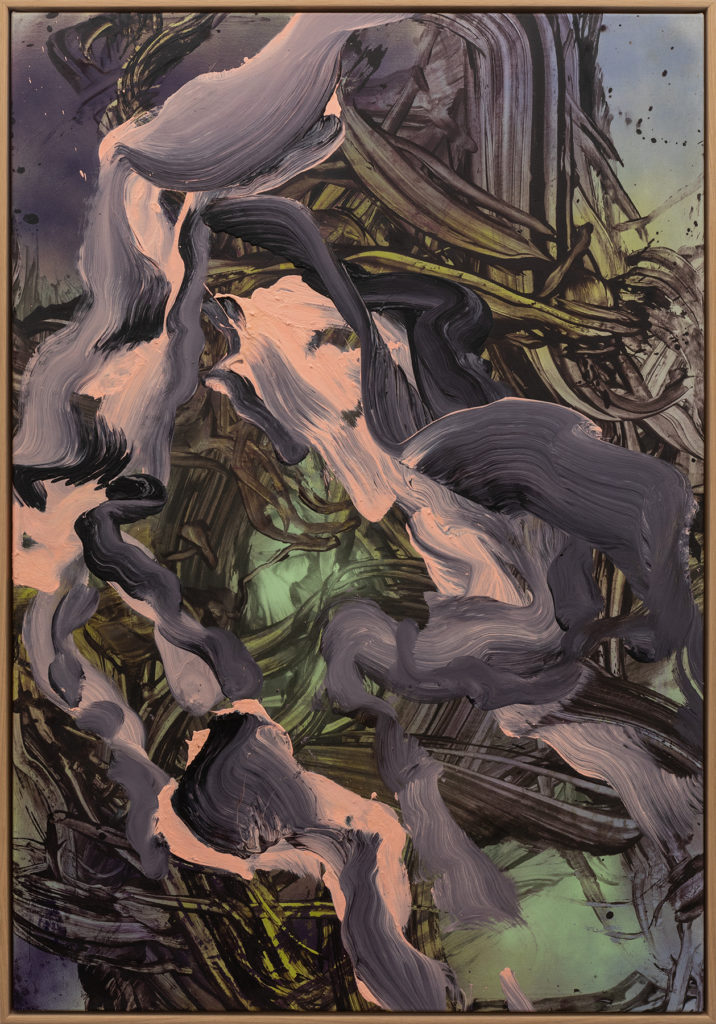
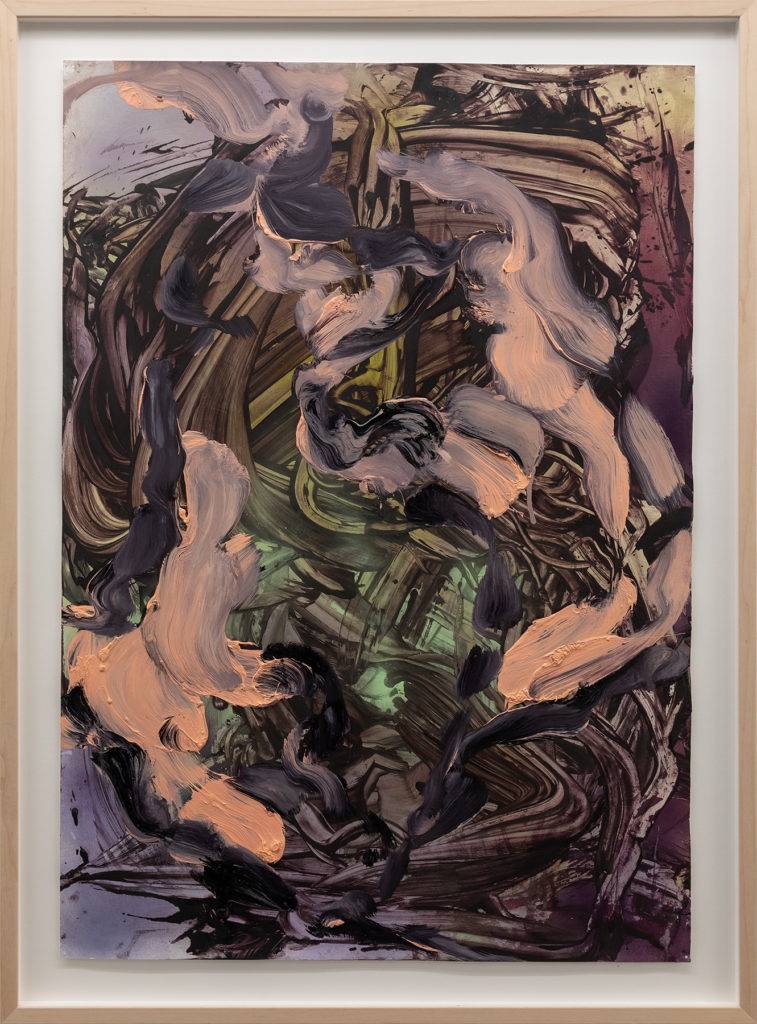
“Untitled, 2005, is both an extraordinary painting in its own right and a key pivotal work in Millar’s œuvre. Alternatively celestial or oceanic, it marks a critical juncture in her practice coincident with the consolidation of her on-going commitment to presence in both Aotearoa New Zealand and Germany and Europe. While pronounced now, this wasn’t necessarily quite so marked when it was first shown in an expansive and experimental exhibition at Auckland Art Gallery “I will, can, must, may, would like to express”from September to November that year. It was the most difficult painting in the exhibition, a building site painting or work in construction as Millar described it in an accompanying exhibition brochure. Certainly unruly, anarchic, even within an exhibition that challenged assumptions as to what painting might entail, it escalated the core motivations of her practice at that time. In an exhibition filled with actual and potential jumping off points, this painting was the most extreme, the most risk-taking and, in a very precise sense given it is such an important concern for the artist, in retrospect it seems to have been the most present.”
P. Shand 2019
18th May – 18th August 2019
In 1965 Roy Lichtenstein created his famous brushstrokes and in so doing transformed the subjective gesture of heroic Modernism into a trivial comic drawing, transposed into the large format of a museum.
Konrad Bitterli, Lynn Kost, and Andrea Lutz curate the extensive Frozen Gesture exhibition – a sheer range of gestures in contemporary painting, presented by Kunst Museum Winterthur. The exhibition brings together important individual pieces by outstanding protagonists of Abstract Art, such as Gerhard Richter and David Reed, with extensive work groups of contemporary artists such as Franz Ackermann, Pia Fries and Judy Millar – to create a fascinating display of works of exceptional painterly quality and inconceivable sensory appeal.

The spontaneous movement of the brush on canvas mutated into a quote, the emotional exploration of depth morphed into a Pop surface in signal colors. The purported immediacy of the expressive painterly act thus became an ironic reflection on the medium of painting using the means of mass culture.
This distanced and self-reflective approach had defined contemporary painting since the end of Modernism. It highlighted the fundamental elements of the image, such as the appearance of the colors and the pigment, the color fields and their limits, and not least the application of paint in the form of a gesture.
This gesture had long since abandoned directly expressing existence in favor of any number of different discursive strategies and painterly approaches. To this day, artists underscore the problematic nature of the impact of the application of color and are forever reinterpreting it – from the gesture as a semiotic abbreviation for painting through to its diverse transformations in images.
Curators: Konrad Bitterli, Lynn Kost, and Andrea Lutz
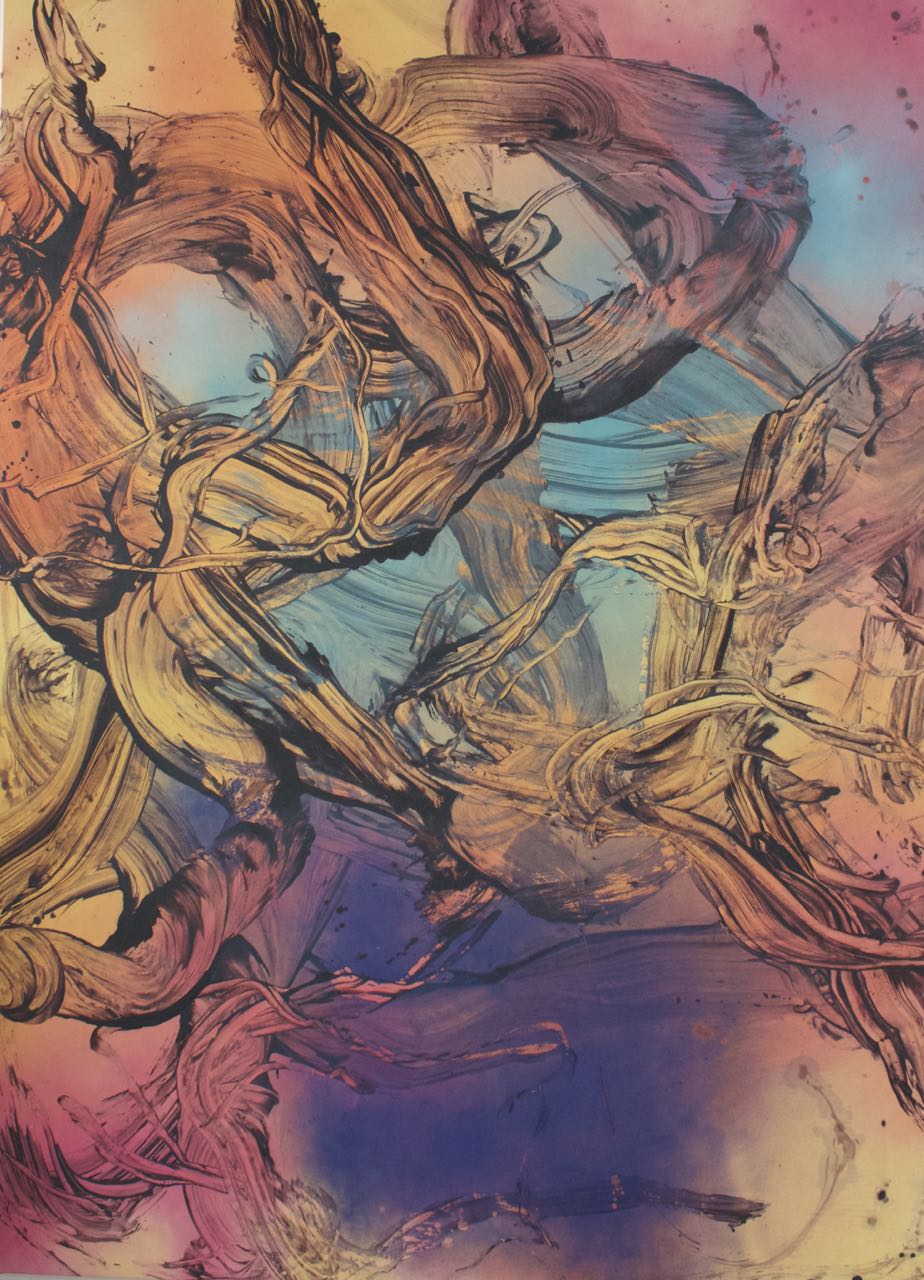
Galerie Mark Mueller presents the group exhibition Single, but happy. Zurich, 8th June – 20th July 2019
17th April – 11 May 2019

Judy Millar, March 2019
I was sitting down to write up notes about this exhibition on March 15th when headlines wrote themselves across my screen. A man and a gun had vented rage and hate against fellow New Zealanders in their time of prayer.
Times like this make you question a life in art, a life that is in itself a kind of devotion. It can seem to lack the necessary force to counter-strike. It can seem too invisible as an influence on everyday life.
The seeming inadequacies of art became even starker when I began to view this desperate act of violence as part of a broader picture appearing around the world. We have long lived in a world that has assumed white superiority but it is fast ramping up, in so many parts of the world, into an outright declaration of supremacy.
We are living in a time where democracy itself seems challenged if not directly threatened. We have reached a point where we make enemies of those who hold different political perspectives than our own. We live in a time where we ‘unfriend’ those who challenge or criticise us. Where we object to listening to opinions we don’t already fully agree with and where we respond with outrage to views that clash with our own. All of these attitudes and behaviours run counter to the core democratic principle of respect for differing opinions.
I have always believed that involvement in art is primarily about absorbing different points of view. Being open to art is about gaining the flexibility to look at things from all sides and in doing so to nourish our empathic humanity. But on March 15th I once again had to ask – is this enough?
I still don’t have an answer to that question but while thinking deeply on this over the ensuing days I stumbled on this quote from Simone Weill. In her Notebooks she writes that we are helped by meditating on “absurdities which project light”.
For now this definition seems a suitable definition for art, and one that can give me some hope as to art’s ongoing importance. At the very least I will take it as a definition of my own project.
I have worked hard to light these canvasses from the inside out. I have sought to combine the paradoxes of coloured earth and a suggestion of the immaterial. I have desired a feeling of space and surface coexisting. I have tried to evoke dusk – the time of day that is neither day nor night but is both at the same time. I have wanted to suggest a multitude of things and nothing at all.
I know this is not enough, but for the interim it is what I can offer. I hope that it will encourage contrasting viewpoints. In doing so it might enable the widening of our individual perspectives.
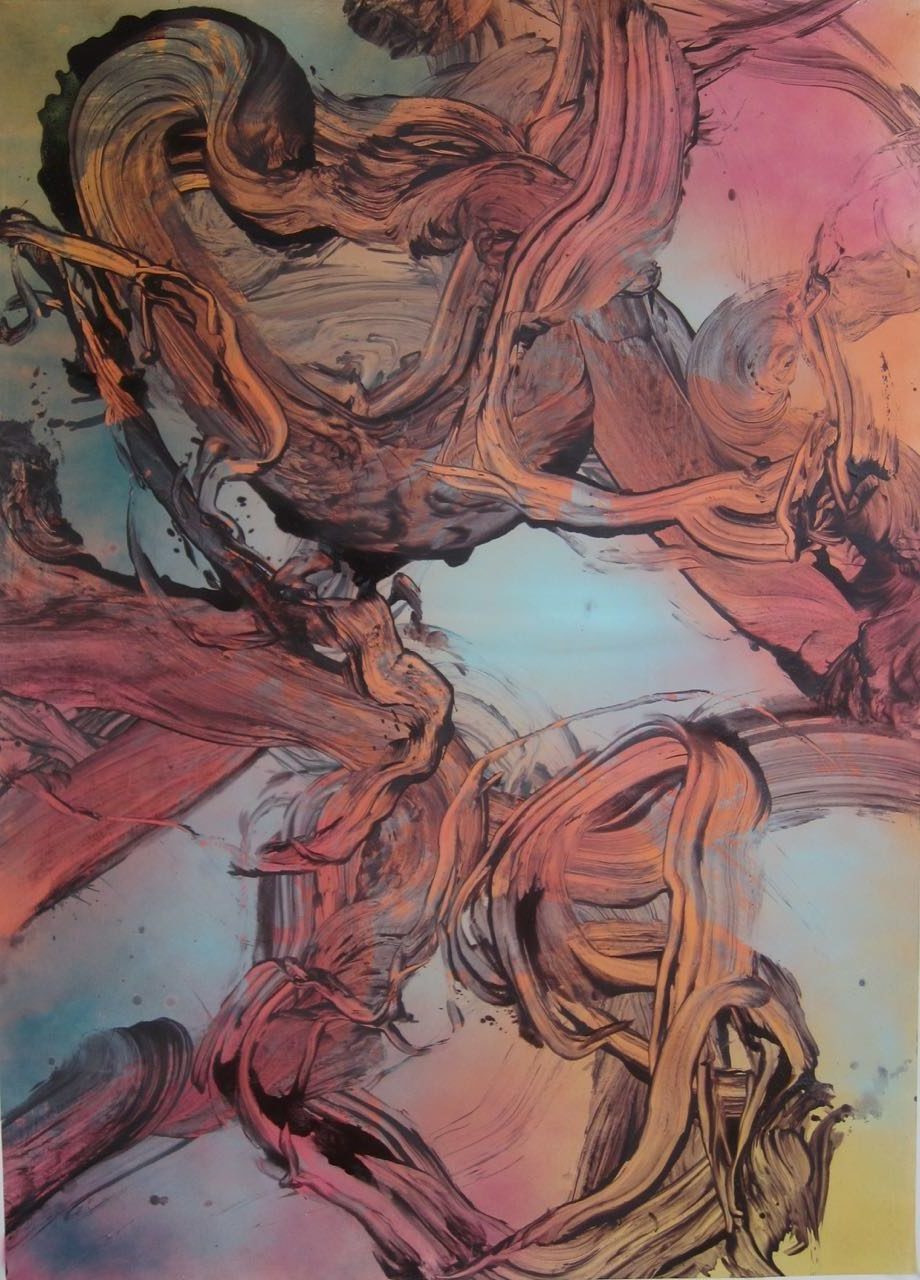
“The gestural and abstracted surfaces of Judy Millar’s art are both intensely physical and highly mediated structures, reflecting the paradox we face of inhabiting both corporeal and cognitive realms.
Millar, a distinguished and internationally acclaimed artist, employs the processes of erasure – wiping and scraping paint off the surface of the work – to create visceral canvasses that invoke a sense of the body.”
art_messenger 2019
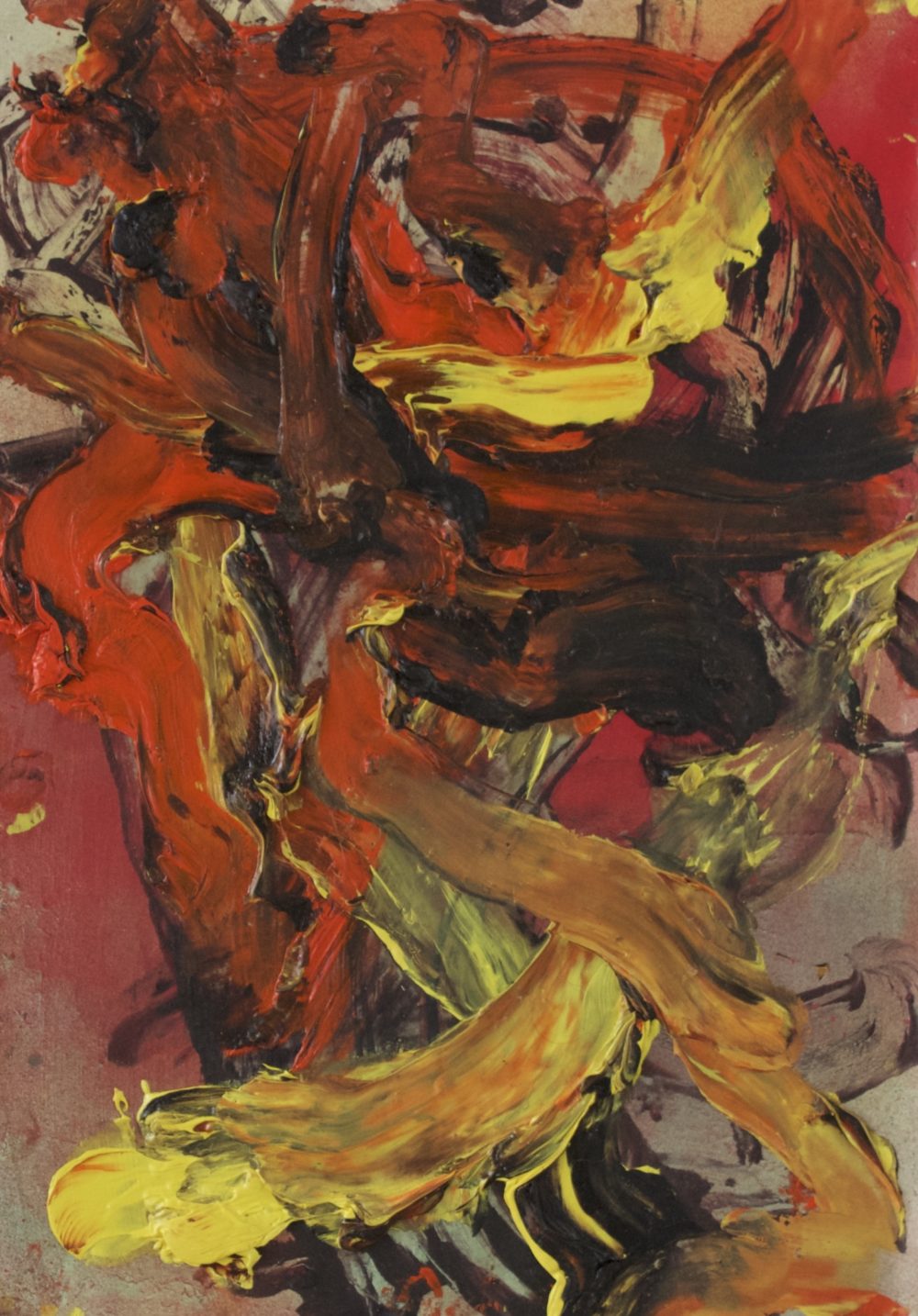
Without the shock and awe of leviathan size these works must be on point. And they are.
https://www.newsroom.co.nz/@living-room/2018/08/24/207068/never-neutral-abstraction-in-auckland
A group exhibition lapping at the shores of heteronormative sanctity, curated by Kate Britton
Sullivan+Strumpf, Sydney
18th August 2018 – 15th September 2018
The Waves borrows its title from Virginia Woolf’s novel of the same name, in which many voices unite in a single narrative. This exhibition likewise unites many voices to tell a single yet multivalent story. This story is about what happens in a white cube occupied by women and non-binary voices, and why we should be listening.
The Waves brings a diverse group of artists into a conversation about feminism, bodies, access to and occupation of space, collective action and gestures of intersectionality. In making their work, each of these artists chip away at the walls and barriers that are thrown up by patriarchal systems, biological determinism, trans-exclusionary feminism, colonialism – the list goes on.
The feminist project has been characterised by waves, a lapping at the shores of heteronormative sanctity. The works presented from these artists engage with different aspects of this project: political, social and labour-based action; reclamation and celebration of diverse bodies and identities; intersectionality; and an emergent collective anger – #metoo.
In bringing together work from Sullivan+Strumpf artists with invited artists, The Waves establishes new lines of sight between the work of diverse women and non-binary people.
Karen Black
Ohni Blu
Polly Borland
Barbara Cleveland
Christine Dean
Joanna Lamb
Lindy Lee
eX de Medici
Sanné Mestrom
Judy Millar
Dawn Ng
Thea Perkins
Katy B. Plummer
Justine Youssef & Leila El Rayes
Hiromi Tango
Angela Tiatia
Jemima Wyman
Studies in Place: Works on Paper 1989 & 2017
8th August – 1st September 2018
Studies In Place – a solo exhibition of small works on paper from 1989 and 2017 held at Gow Langsford Gallery. The works from 1989 show Millar’s immediate response to the wild landscape of Auckland’s West Coast when she first moved there soon after leaving art school. The recent works track her newfound reflection on the importance of place; place not only considered as a location but more importantly as a set of determining circumstances.

“I seemed to spend the greater part of my early life searching for a place to look out at the world from. My favourite childhood game was a blanket draped over the family dining table providing a place in which I could secure myself. Hidden within the folds of fabric I could create a new realm that gave me the privacy I longed for.
Virginia Woolf’s “A Room of One’s Own” later confirmed it for me. Every woman needed a space defined for her, by her.
What it was that pulled me to Auckland’s West Coast as a young person I’ll never be completely sure. But there I found the mental freedom I longed for – a freedom that let me define my own existence as if back in the blanket hut. The wild storms neutralised by own inner turmoil: an external and internal pressure meeting and rebalancing one with the other. The sound of wind in the trees and crashing against the house became a valve that allowed me to inhale and exhale more fully.
Then the visuals – the views from up high as if floating above the land. The colours that changed throughout the day reaching a new saturation as each day’s sun set. Overwhelming, yes. But life giving too and so as I began to work I found my body respond in new ways.
The first ‘coast works’ in their primary saturations have remained unseen by anyone else since the late 1980’s. They have been harshly edited over the years with many being burnt. Those remaining seem now to be a nucleus of thoughts and responses that have emerged decades later.
All these small works are the direct result of being in a place: a place that has become my intimate world. The trees and plants have grown with me, around me. The wind has screamed at me and I at it. From the garden I eat. The sea air has seasoned my lungs well. I have both arrived at and imagined a place.”

Judy Millar solo exhibition, Sullivan + Strumpf, Sydney, Australia
6 April – 28 April 2018
The gestural and abstracted surfaces of Judy Millar’s art are both intensely physical and highly mediated structures, reflecting the paradox we face of inhabiting both corporeal and cognitive realms.
Millar, a distinguished and internationally acclaimed artist, employs the processes of erasure – wiping and scraping paint off the surface of the work – to create visceral canvases that invoke a sense of the body.
“Without our body we don’t exist, this to me is our experience of the world and this is what paintings can directly address.” – Judy Millar
Millar’s painterly practice also incorporates various printing techniques and digital reproduction, which allow her to push the possibilities of scale by enlarging and exaggerating the painted surface. Through exaggerations of scale, her expressive paintings saturate the viewer and become commanding expressions of embodiment.
13 April – 4 May 2018
Much of Judy Millar’s work is rooted in a childhood hunch. The young Millar intuited an elusive ‘something’ concealed behind the facade of the material world – a somewhat precocious permeation of the regular monster in the closet complex, with a universe-sized closet and metaphysics lurking in lieu of a monster. Most kids get over this sort of thing, but the distinct sense of something beyond our senses mystifies and intrigues Millar to this day.
In tandem with this playful metaphysical paranoia, Millar has maintained a longstanding commitment to the process of painting. Her oeuvre looks less like a collection of thoughts and paintings than a montage of thinking and painting in action.
Within her practice, constant artistic experimentation and mystic inquisitiveness engage and invigorate each other, together forming the engine of her creative evolution.
Perpetually refining her approach to art making in open defiance of inertia, Millar’s lifetime of innovations and insights has lifted her practice beyond New Zealand’s borders and into the international sphere.
As one might expect from an artist investigating the ambiguous nature of experience, Millar eschews direct symbolism in favour of allusion and impression. Her paintings, unimpeded by figuration and singular notions of meaning, deploy a kind of psychedelic abstract-expressionism in service of philosophical and aesthetic play. Blank canvases are transformed by the application and erasure of paint into writhing gestural labyrinths of form, torsion and colour.
One is left with the singular impression that Piranesi has returned from the dead, imbibed illegal substances, and tried his hand at contemporary abstraction.
Digitised brush strokes loop impossibly, penetrating amorphous clouds of luminous colour; here space is treated like paper in the service of origami: flipped and folded, turned inside-out, played with. Our tacit acceptance of the solidity and reality of things is upended and the universe is delivered from our comprehension into mystery. It’s quite good fun. Her work, in a delicious contradiction, is ludic to the point of seriousness – navigating portentous philosophical and aesthetic territory in a bewitching state of frolic. One can’t help but detect the notes of her joy in these meditations on painterly process and metaphysics – a joy so often in absentia in the discourse on such topics.
These elements are conspicuous in a practice that operates in an increasingly diverse array of mediums. Whether she’s charming children with a pulley-operated, large-scale fold-up-book (replete with projected visuals), crashing immense waves of canvas against the rigid ornamentation of baroque church architecture or erecting monumental sculpture that tumbles from the heavens, Millar invokes the invisible subtext underlying the appearance of reality.
Oscillating between her off the grid residence in NZ and her home in the Metropolis of Berlin, she continues her investigations of appearance and reality, poking with her paintbrush, year after year, at the beguiling veil.
January 25th – February 17th 2018
Photos courtesy of Robert Heald Gallery.
26 October – December 2017
Blood red, jade green, and a bruising purple resonate against yellow and incandescent orange in Judy Millar’s new paintings.
The colour palate is double-edged: reminding us of the moments when nature thrills us with sunsets, sunrises and deep blue lagoons but also recalling the colours of comic books and their depictions of outer-space adventure and future doom.
Millar, a fan of popular science, describes the activity of painting as a form of space travel. When painting Millar experiences space and time merging. As the title of the show suggests, during this process she feels “swallowed in space”.
In this new group of works form becomes the graph of activity. The appearance of “things” emerges from the web of painted lines and fields of colour. Things hard to name but fleetingly apparent establish a semi-believable pictorial space. These strangely spatial paintings exude an otherworldly luminosity as if emitting light from a distant time and place. As Millar applies then removes layers of paint from the surface of the works she seems to release energy as if an image has been held in matter and is now freed into visibility.
Full exhibition history here.
July 2017 – July 2019.
In the South Atrium of the Auckland Art Gallery resides my latest major site-specific commission, Rock Drop 2017. Acquired by Auckland Art Gallery Toi o Tāmaki with the support of Auckland Sculpture Trust, Auckland Contemporary Arts Trust and Auckland Art Gallery Foundation’s 2016 annual appeal.
“This work plays with the complexity of the vibrant junction between the Victorian, neo-Classical and 21st century architecture of the building, Millar’s towering painterly installation responds to the dynamics of the space and appears to change and morph from different perspectives, provoking new and exciting experiences for Gallery visitors.” – Curator and Gallery Director, Rhana Devenport. 2017
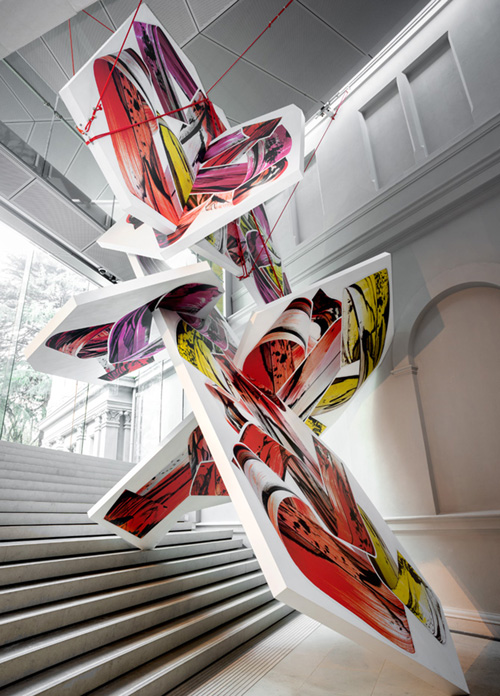
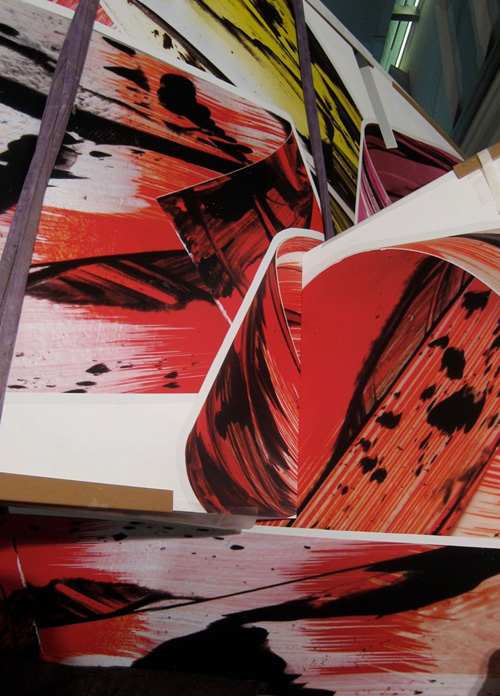
30th August – 24th September 2016

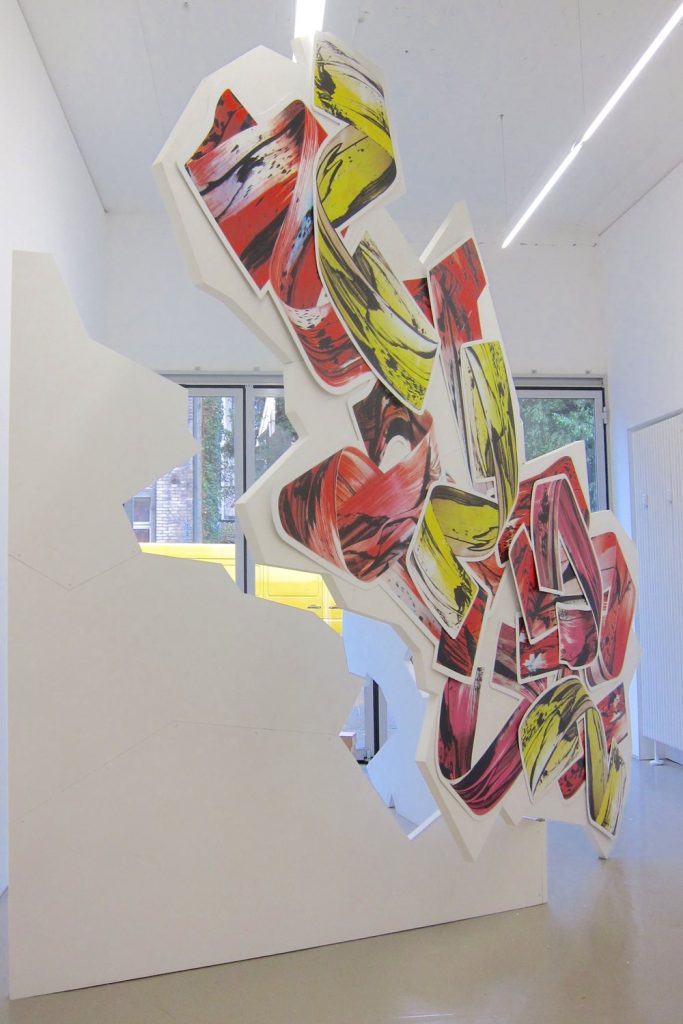
Image: Judy Millar, Advancing All Electric, 2016. Installation view, Galerie Mark Müller, Zurich. Photo: Millar Studio. Courtesy the artist.
Merzbau explored new spatial ideas in art, and my work also relates to new kinds of space, specifically combining elements of architecture, sculpture and painting. I am also interested in the idea of collage that Schwitters was using. Of course, he was collaging everyday material, and I am reassembling digital reproductions of my own painted images. The worthwhile thing about showing in Europe is that you get these very new takes on the work that you are doing—connections that wouldn’t be immediately made here, in New Zealand.

Image: Judy Millar, Untitled, 2016. Acrylic and oil on paper, 89 x 64 cm (incl frame). Courtesy of Bartley + Company Art.
They are called ‘space works’. In the studio we call them ‘props’ rather than sculptures. I would always bristle when the people I work with in the studio called them ‘sculptures’. So we came to the decision that we would call them props—I quite like the word.
Yes, they are a spatial collage in this respect, so this does fit quite well with the Merzbau concerns. On the surface of the structure, I am placing images of other forms that I’ve made in three-dimensions then photographed and had printed onto sticker paper. So the main space work has images of other spatial works hanging on its surface. These images really are like big stickers on the surface of the work. Each of these stickers is stuck to a piece of thin aluminium that is then gently curved in different directions. The difference with this new work is that the stickers, instead of being flat on the surface like previous works, curl away, gently lifting away from the form itself.
So it is quite a complex piece that involves both illusionistic curves and physical curves—real shadows and images containing shadows. If anything, these works are lampooning big heavy ‘male’ sculpture. It is a very gentle dig. These are stickers! It is everything that you shouldn’t do with a traditional sculpture: it’s illusionistic, it’s not real, it’s plywood made to look like cardboard, and it carries images on its surface.

Image: Judy Millar, Advancing All Electric, 2016. Installation view, Galerie Mark Müller, Zurich. Photo: Millar Studio. Courtesy the artist.
I try and undo them because I want to understand them. My way of understanding something is to pull it apart. A good sculpture is about a form in the round that both alters and is altered by the space that surrounds it. But I am more interested in it existing as an image rather than a form. This recent spatial work is primarily made up of slotted planes—it is planar in the sense that it is really just an image surface that has become a little more complicated.
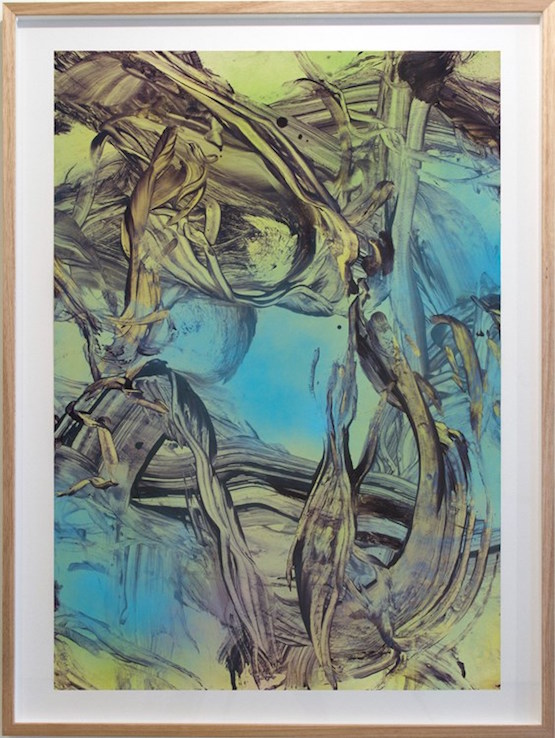
Image: Judy Millar, Untitled, 2016. Acrylic and oil on paper, 115.5 x 86 cm (incl frame). Courtesy of Bartley + Company Art.
Yes, an absolutely central interest of mine is how a painting alters its spatial environment. On one level, the painted works are a ‘finding out’ process that includes some really basic stuff about how colours interact and how the very fluid and incredible medium of paint functions. But I am painting these works flat on the floor and when I am doing this, I am trying to build an entire space. It is not that I am just thinking of a two-dimensional planar surface on the ground. It is as though I am trying to build a dome-like space above the canvas. I am in space; my movements are in space. So the painting is really about creating a form of space. It almost lands on that plane with the hope that, when I put the canvas upright, it is going to then come into the viewer’s space—that it is going to determine this space or influence it in someway.
The word that always sets my teeth on edge is ‘gesture.’ Gesture seems like something that comes gushing out from deep inside you. That is not really what I am interested in. My work is much more about drawing; it is about looking and seeing, less about ‘expressing’. I’m using gesture only in the sense that a gesture can communicate something.
But Abstract Expressionism did produce some pretty amazing work and it also fell into a very big hole. I think there is something in there that is still worth exploring—that is still worth bringing forward. But like everything that is continually repeated, Action Painting became nothing but a mannerism. And I am very aware that I am referencing this form of painting in a ‘gone’ way. I am not really parodying it; rather I am referencing a ‘gone form’. It is a form that already stands for something. This continues to interest me greatly with painting. — Read original article here.
11 June – 23 July 2016
More information about Advancing All Electric can be read in A conversation with Judy Millar, an essay written by Kate Brettkelly-Chalmers for Ocula.
20 April – 7 May 2016
30th October – 15th November 2015
Call Me Snake, a temporary sculpture commissioned as part of Christchurch’s Scape Public Art initiative, SCAPE 8.
Made from steel, plywood and digital print.
Millar is best known for her large-scale digitally printed and painted canvases, which loop and undulate through architectural spaces, exploring ideas of scale, and the compression of time and space. Her work for SCAPE 8 New Intimacies, Call me Snake, pushes these ideas beyond the enclosed architectural spaces she has previously worked with, into the Central Christchurch landscape.
Full article here.
29 May – 26 June 2015
Excerpt from i-D Interview.
In the past decade, acclaimed New Zealand artist Judy Millar‘s varied work has filled a German gallery with Technicolor tidal waves and unspooled wild brushstrokes across the walls of a Renaissance church for the 53rd Venice Biennale. Always a fan of an enveloping spectacle, her latest show Reverse Cinema at Sydney’s Sullivan + Strumpf draws on painting, sculpture, and light projections to create an installation that’s both soulful and cerebral. With the show involving her most audacious work yet, i-D chatted with the artist about her allergy to categories, falling in love as an intellectual experiment, and why she dreads public art.
Read the full article by Neha Kale for i-D. Or download here.
The library designed by Athfield Architects Auckland opened in February 2015.
30 April – 3 May 2015
Featuring artists: Elena Bajo, Stella Geppert, Judy Millar, Yorgos Sapountzis, Peter Welz and Michaela Zimmer.
3rd March – 28th March 2015
In this exhibition, Millar exhibits a large group of paintings generated in her Berlin studio. Taking cues from the colours found in post-apocalyptic comics these works glow with an otherworldly light, mysterious and unsettlingly beautiful. Forms appear to emerge and disintegrate in an unstable world of things half-seen and impossible to recognise.
13th February – 1st April 2015
Judy Millar: The Model World
In the theatre world, models are miniature sets used to test the placement of images and objects in a specific space. Like a life-size model world, Judy Millar’s recent work combines a projected image, moving components, and painted and blank surfaces, which collectively could resemble an artist’s studio or an engineering workshop – both sites for production and experimentation or creativity through play. Visitors are encouraged to participate and occupy Millar’s constructed world by transforming flat-folded works into three-dimensional pop-ups and casting exaggerated shadows while moving through the gallery, making explicit the subjective and ambiguous relationships that influence our experience of paintings; between painting and space, image and form, the real world and its mediated imprint on a surface.
The Model World also extends on our new publication, Swell, a pop up book for children and the result of a collaboration between Judy Millar, writer Trish Gribben and paper engineer Phillip Fickling. Millar’s paintings were turned into twisting, swelling and heaving pop-ups that folded neatly between the pages. Here, paintings shift scale again to take on a larger-than-life presence as a further exploration of the degrees of separation in the painting process that playfully but persistently rejects the notion of a painting as a discrete, mimetic object that represents the world but is not subject to its forces.
A solo show of Judy Millar at Galerie Mark Mueller, Zurich, Switzerland.
11 October – 15 November 2014
Press Release by Pascal Marchev.
Judy Millar: Paintings
Nachdem Judy Millar in den vergangenen Jahren ihren Gestus auf unterschiedliche Weise zu analysieren und hinterfragen versuchte, indem sie eigene Bilder beispielsweise digital bis zur Verpixelung vergrösserte und mit Siebdruck in die Leinwand-Arbeiten miteinbezog, kehrt sie in ihrer 5. Einzelausstellung in der Galerie Mark Müller, wie der Ausstellungstitel bereits erahnen lässt, zurück zur Malerei in ihrer reinen Form.
Ihre Bewegungen, mit denen sie unter direktem Einsatz ihres Körpers die auf dem Boden liegenden Leinwände mit Farbe bedeckt und verwischt, werden durch eine symbiotische Verbindung von Körper und Geist geleitet, welche sich gegenseitig beeinflussen. Intuitiv setzt sie Bilder aus ihrem Innern in eine Malbewegung um. So sind ihre Arbeiten auch nur auf den ersten Blick fern jeglicher Gegenstandslosigkeit. Im Gegenteil, sie versucht bewusst die Wahrnehmung des Betrachters herauszufordern und geht dabei einer der grossen Fragen des Menschen nach: Ist die Welt, die ich erlebe dieselbe, die jemand anders erlebt? So spielen auch die Titel der mittelformatigen Leinwandarbeiten „Flicker Rate“ auf die Theorie an, dass sich die Welt zu jedem Moment in verschiedenen Zuständen befindet, ähnlich wie Schrödingers Katze zugleich lebendig wie auch tot ist. Wir als Betrachter nehmen durch ein ständiges Flimmern jedoch nur eine einzelne Realität wahr.
Mit unserer Wahrnehmung spielt auch die formale Zusammenstellung der Arbeiten, welche alle in diesem Jahr entstanden. In farblich zusammengehörigen Gruppen gehängt, innerhalb derer jedoch Grösse und Medium variiert, werden die Grenzen zwischen den einzelnen Arbeiten aufgelöst. Es scheint, als betrachte man dasselbe Bild in unterschiedlichen Zoom-Stufen. Man wird eingesaugt und wieder abgestossen von den fraktal-artigen Formen, die so typisch sind für Millars Technik. Das was sie also mit dem digitalen Aufblasen ihrer Malerei vor zwei Jahren untersuchte, zeigt sich auf eine Art in den jetzigen Arbeiten erneut. Im Vergleich zu der zweidimensional wirkenden Siebdruck-Schicht, lassen uns jedoch die aktuellen Gemälde ein ganzes Universum entdecken, in welchem man als Betrachter in immer tiefer liegende Schichten eintaucht. Ein Universum, eingefroren in einem bestimmten Moment, erzeugt dabei einen spannungsgeladenen Widerspruch zu dem so dynamischen und zeitlich andauernden Malprozess, der jede Arbeit in der Entstehung voneinander trennt und eine direkte Verbindung ausschliesst.
Die Hängung innerhalb der beiden Räume der Galerie Mark Müller führt dieses „in and out“ – dieses Eintauchen von einer Arbeit in die nächste – noch weiter indem die erstaunlicherweise kleinste Leinwandarbeit wie ein Portal die zwei Räume verbindet. Sie lässt den Betrachter mühelos von einem Raum in den nächsten springen. Ein Wurmloch von einem Punkt des Universums zu einem anderen.
Essay download.
Published in December 2014.
Published by Te Uru Contemporary Gallery Waitakere (formerly Lopdell House), Titirangi, Auckland, New Zealand. Swell is an artwork for children that is a pop-up art book.
An enchanting pop-up book full of Judy’s painted twists, twirls, swells and swirls. Possibly the first artwork /art-book in many children’s lives. A paper engineering masterpiece, Swell is a collaboration between writer Trish Gribben, paper engineer Phillip Fickling, and painter Judy Millar.
Gribben and Millar presented the book at the Auckland Writers Festival on May 17, 2015. The book was officially launched on the 5th December 2014.
Press relating to the publication: Christchurch Art Gallery | Stuff.co.nz | YouTube | Gow Langsford
Available from: Good Reads | Wheelers | Te Uru Waitakere | Scape Public Art
The Art of Hair is a celebration of the history between two friends, Paul Serville and Judy Millar, combined their creativity for the 2014 Servilles Winter campaign. A sneak peek video of what went on behind the scenes can be viewed here.
Check out Servilles site for an exclusive interview with the creative duo, or immerse yourself in what was a fabulous campaign celebrating The Art of Hair.
11 February – 11 May 2014
Cinema & Painting examines the intersection of these two screen-based arts against the backdrop of a culture characterized by the increasing plasticity of pictorial surfaces and flexibility of spaces of viewing.
Space Work 7 – wood, paint and digital print
Public Program is available for download here.
5th February – 1st March 2014.
The second solo exhibition of Judys work in the gallery. The title drawing attention to the role of colour in Millar’s work; hot, strong, joyful, fiery, wild colour.
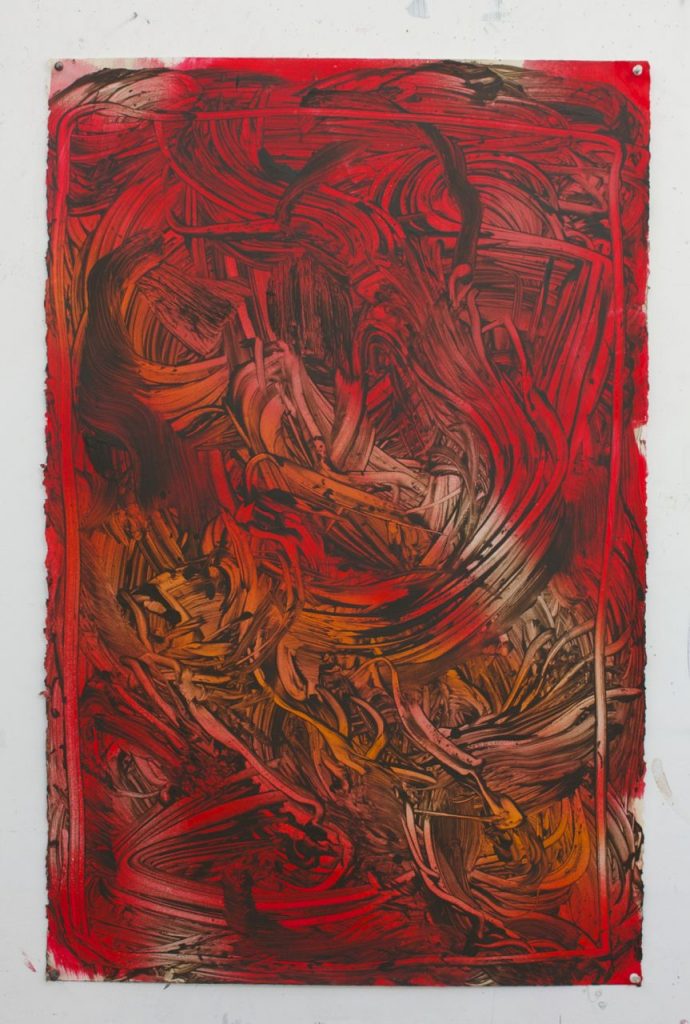
Much has been written about the Millar gesture – its bold, expansive, assured form swirling across her chosen surface whether canvas, paper or vinyl or, as we have seen most notably in her Venice Biennale exhibitions in 2009 and 2011, taking painting off the wall and into sculptural form out into space and the world. However here in this exhibition of three large and one smaller painting, paint remains contained and the place of colour in her work is foregrounded.
It is this colour that we respond to emotionally or sensually in the first instance before the intellect steps up and engages, drawing us in to Millar’s underlying project – a sustained investigation of the issues and challenges of painting and its place today’s visual economy today.
Rather than the issues of representation and the tension between two and three-dimensional space that have more often been discussed in relation to Millar’s work, what first comes to mind here are ideas about how painting engages with the emotions.
Again history provides the springboard with Kandinsky and his colour theories and Rothko and the colour field painters of the mid 20th century providing the starting point to let us think both about how art makes us feel personally and how it operates in a way that is quite different to its antecedents.
Formal purity is not a concern of this 21st century abstraction, what is more relevant is a kind of subversive questioning of possibility and progress.
11th May – 8th June, 2013
Excerpt from Art Collector
I Give You The End of A Golden Thread will be Judy Millar’s second solo exhibition in Australia. In it, Millar succeeds in creating an experience of painting through which both hers and the viewer’s world is directly addressed via a perpetual motion of ideas which inform the work. In both this body of work and in her upcoming solo at the Institute of Modern Art, Brisbane in June, Millar has moved away from the academic and conceptual to create a highly personal exhibition.
February 2013.
Comic Drop an exhibition of new works by gallery artist Judy Millar. Millar is one of New Zealand’s most exciting contemporary painters who shares her time between a remote property in West Auckland and inner city Berlin – where her career continues to gain momentum.
Comic Drop brings together a series of new works that combine exaggerated enlargements of handmade gestures with vivid colour. In these works Millar continues to takes on the history of expressive painting and turn it inside out.
Recent career highlights include two exhibitions at the Venice Biennale representing New Zealand with her solo exhibition Giraffe-Bottle-Gun 2009; and in Time, Space, Existence a curated exhibition at Pallazo Bembo in 2011. Her work is about to be featured in a large exhibition of star international art in the Czech Republic and an upcoming solo exhibition at IMA Brisbane, Australia.
Excerpt from Frankfurter Kunstverein
The term “contact” refers to the network of relationships between the two dominant ethnicities in bi-cultural Aotearoa/New Zealand: the indigenous population of Māori and the white settlers, “Pakeha”. Video works by Lisa Reihana, for example, deal with themes of cultural oppression, the search for cultural identity, and the struggle for self-determination.
New technologies and old myths are intertwined in works by Rachael Rakena, while Francis Upritchard creates new, hybrid forms based on historical objects. Issues related to the complexity of multicultural society in the scope of a powerful influx of immigrants from the Polynesian islands, as well as the fate of a life in exile, are reflected in the photographs of Edith Amituanai. “Contact” not only presented works that artistically address socio-cultural conflicts in today’s Aotearoa/New Zealand, but also ones of a more poetic nature, like works by Dane Mitchell or site-specific installations by John Ward-Knox.
“Contact” outlines a complex portrait of artistic production of the last forty years in Aoteaora/New Zealand. Here works are not used to illustrate a single thematic point, rather the aim is to create a multifaceted perspective of a highly active and heterogeneous artistic scene within the context of a contemporary dialogue.
The title of the exhibition is expanded conceptually to include the artistic methods and processes of painters like Judy Miller, who, alongside Francis Upritchard, represented New Zealand at the Venice Biennale in 2009, or Simon Ingram, who employs a programmatic approach devoid of subjective intervention in his “Automata Paintings”.
Curators: Leonhard Emmerling, Aaron Kreisler

Read full article.
Published by Kerber Verlag, Germany 2012
This Collector´s Edition consists of 80 exemplars, each one comprising an original work (acrylic on paper, 29.7 x 41.7 cm) by the artist and a fanfold publication, The Rainbow Loop.
Judy Millar’s works are distinguished by an intensive exploration of informal painting and Abstract Expressionism. The edition of original works is the result of individual, rolling processes that question interior and exterior, beginning and end. Each work of art is unique.
Available for Purchase.


1st May – 25th May 2012
Excerpt from Spectrum, May 5-6th 2012.
Commanding brushstrokes of thin paint are wiped, erased and manipulated across the picture plane to create the distinctive interwoven complexity of line in Judy Millar’s work. The artist then blows up the image digitally, silkscreen prints it and paints over with metallic, shimmering colour.
This is the first show in Australia in a decade for the New Zealand artist, who represented her country at the 2009 Venice Biennale.
April 14th – June 14th, 2012.
In The Rainbow Loop, Judy Millar shows an individual work that describes a lurching process of a single painterly image, its digital reproduction, its expansion and elevation in space.
This gives rise to a work inside and outside and early as the end of one questions it dances and rolls through the exhibition space, it changes our perception and invites us to experience a temporary twisted world.
It questions how we reconcile our physical and mental existence, how we distinguish between illusion and reality, and how we form a connection from the myriad of our fragmentary perceptions.
Original publication.
A revealing aspect of abstract painting like that of Judy Millar is its minimum referential character. Colors, shapes, and movements cannot be decoded using a canon of signs taken from the world of things but function in a primarily selfreferential fashion. Meaning and content are thus conveyed in an abstract system, which Judy Millar seeks to explore in her current works.
The title is taken from computer terminology, and describes a so-called LIFO (last in-first out) method for organizing (abstract) data systems, where the last information that is entered into a system is the first to emerge from it. The instruction “push, pop, stack,” applied to Judy Millar’s painting, can best be observed in her process of creation, which is characterized by multiple acts of application and removal, adding and deleting. Paint is applied to an unmounted canvas lying on the floor, and then once again removed using a scraper, brush, or the artist’s bare hands. This process, repeated several times, leads to the state of reduction that Judy Millar strives for. Each new layer sets itself apart from the previous, allowing no more than a single trace of the painted shapes beneath to shimmer forth. And yet, the accumulation and obliteration of these supposedly nonreferential gestures can achieve the level of great tension and presence that marks the “finished” motif. Judy Millar tries to capture precisely how this moment comes about in her latest works by photographing these small-format paintings, and then after a color correction transferring them through a complex grid-point silkscreen technique to much larger formats. The same motif is thus transformed into various states. In the large formats, it is the blow up of two motifs on differently painted canvases that is able to express Judy Millar’s intention with a certain urgency: the significant moment in the genesis of the work in which painting condenses to a statement is not only explained by repetition, but also illuminated in countless possible applications.
1st May 2010 – 4th June 2010
New Zealand artist Judy Millar, who lives in Auckland and Berlin, is exhibiting at the Hamish Morrison Galerie in the German capital, her first solo show — entitled ‘A Better Life’ — since her major installation in La Maddalena at the 29 Venice Biennale.
Large lengths of canvas printed with Millar’s painterly marks flow through the confines of the gallery like collapsed billboard advertisements, lying piled up and curling over themselves. Millar explains: “Yesterday while travelling through the city by cab I saw an image that corresponds closely to the piece I’ve made for the show. A shampoo advertisement of a many-storied high head had hair falling in curls down a building’s facade and around the building’s corner. The curls gained volume and contour from the building’s form while at the same time deconstructing the building’s outline.”
Millar is currently completing a three-month residency at the ISCP programme in New York. ‘A Better Life’ runs through June 5 2010.
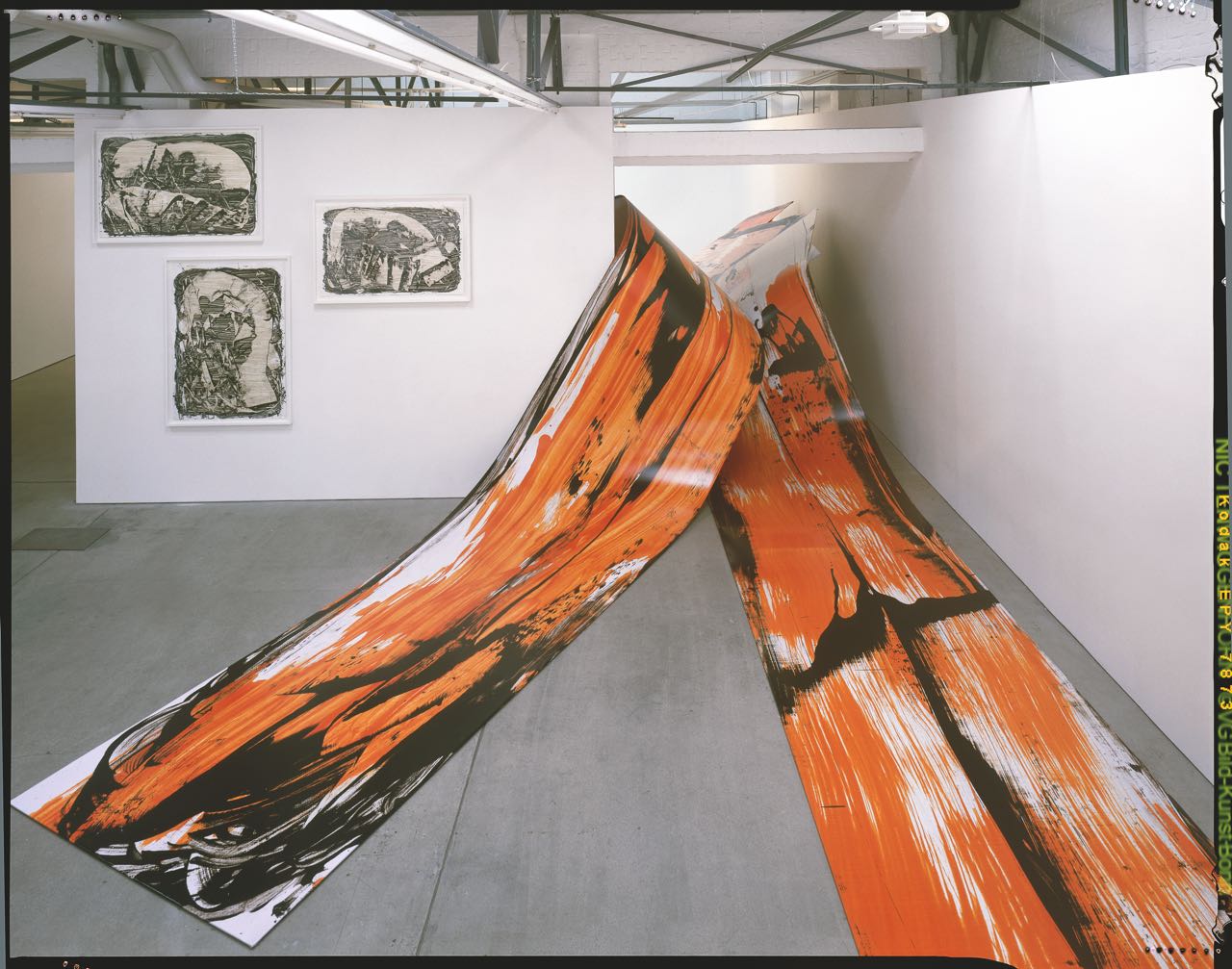
Excerpt from Artsy
Judy Millar’s large-scale gestural paintings defy dimensions and seek to interrupt and invade the spaces they occupy. A signature of her practice is the creation of long, looping paintings that appear to pour out from the wall, forming large coils in the gallery space.
Colliding notions of space and time, Millar’s paintings are, in a sense, four-dimensional, distorting the typical temporal experience of art.
Whether in these tumbling paintings or her more conventional, flat canvases, Millar’s brushwork is gestural, her palette consisting of stark black and vibrant colours. She views the paint itself as an occupying a plane of its own: paintings are illusions and ideas, the canvas merely a physical support.
